Official XSEED Games tumblr. We publish video games and like Onii dolls. Consider this a revival of our XSEED blog, but rebloggable! We'll try to keep the news out and the fun and personal details in. Someone might post a blobfish or two. You never know. If you would like to read about our early adventures, you can read them here!
Don't wanna be here? Send us removal request.
Text
The Localization of SENRAN KAGURA Burst Re:Newal

Over the course of the SENRAN KAGURA series so far, we’ve seen the characters grow in meaningful ways. They’ve become more self-confident, gained greater respect for both friends and foes, and made progress in working through their troubles. So what’s it like going back to the beginning of all that?
To answer that, first we need to go back to the development of the original Burst. We’ve talked about this a few times before, but the original game was written as a standalone story, without any sequels in mind. In terms of back story and basic worldbuilding, Burst is perhaps the most in-depth out of any game in the series. But in terms of the characters’ arcs, it’s a bit out of sync with the later games; at one point, for example, Yagyū tells Hibari that she’s perfectly capable and just needs more confidence, while other games, particularly in the early series, have Yagyū doubting Hibari’s capabilities until circumstances force Hibari to prove herself...
Read More
#Senran Kagura#senran kagura burst re:newal#anime#localization#xseed#xseed games#playstation#playstation4#steam#PC#Gaming
15 notes
·
View notes
Text
Localizing SENRAN KAGURA Reflexions

The SENRAN KAGURA series’ fan service has always been plain to see. Usually, when we talk about the series here on this blog, we like to highlight what else it has to offer: the storytelling, the character development, the way the characters’ relationships grow and change from game to game.
So, to get it out of the way right off the bat, Reflexions is not about those things at all. It’s unapologetic fan service through and through, and we wanted to write this to give everyone an idea of what to expect from it.
Read More: https://goo.gl/xuZ9vY
109 notes
·
View notes
Text
The Official Ys: Memories of Celceta PC Features Blog

So, are you all enjoying Ys: Memories of Celceta on PC? YOU DID BUY IT, DIDN’T YOU? DIIIIDN’T YOU?! …Ahem. Yes, I’m sure you did. So, moving on…
The game was ported from Vita on our behalf by Hyde – the same wonderful people who ported Ys SEVEN for us last year. And of course, neither we nor they are the kinds of people to just take a Vita game, slap it on PC, and call it a day; we wanted to make the experience feel like a natural fit on PC, with all the bells and whistles modern PC gamers have come to expect from the very best titles. Additionally, we wanted to ensure it was worth your while to play this version of the game whether or not you’ve played the original version before. The idea of a “quick and dirty” port really isn’t in our lexicon!
This brings us to the topic of today’s discussion: what’s new in Ys Celceta? Why should you buy this game (WHICH OF COURSE YOU WON’T NEED TO DO SINCE YOU ALREADY HAVE, RIIIIIIGHT?), and what can you expect when you fire it up for the first time? ...
Read More: https://goo.gl/BW2qLR
61 notes
·
View notes
Text
What’s new with Bullet Witch?

What’s going on? Jason here and it’s my first time writing up a blog post so go easy on me. I’m here today to talk about our latest title release: Bullet Witch on Windows PC. Now, I’m sure some of you haven’t even heard of this game. Bullet Witch was originally released on the Xbox 360 back in 2006.
But why now? Why bring Bullet Witch to PC? Well, we thought this had potential to be a fun action game with some tweaks and adjustments for modern gamers. I was a PS3 man, so I never had the chance to own an Xbox 360, which meant I never got to play this game. I first tried the original Bullet Witch game around August 2017, and boy, was it rough. The screen was dark, the game wasn’t very responsive, the AI was too buff and dumb, and the framerate was awful. We thought if these things could be fixed, the game would be much improved.
So, when the developers came to us for improvements, we had a few things on our list to bring this title in line with our other PC releases:
Read More: goo.gl/6Y3A19
39 notes
·
View notes
Text
LoH: Trails of Cold Steel II PC Guest Blog from Peter “Durante” Thoman
It has now been a bit more than half a year since Trails of Cold Steel was launched on PC. That was the first game for which I contributed the majority of the porting effort, and it made me believe that I could also take on a complete end-to-end porting project for its sequel. That sequel - Trails of Cold Steel II - was released yesterday, and in this blog post I’ll talk a bit about all the features it implements beyond what was seen in the previous releases.
Read More: https://goo.gl/njM9gM
75 notes
·
View notes
Text
Zwei: The Arges Adventure - Localization Blog #4
Greetings, future Zweiholics! Are you ready to learn a bit more about Zwei: The Arges Adventure, our upcoming action RPG slated for release on Steam, GOG, and The Humble Store by Humble Bundle on Wednesday, January 24th? Well… you’re in luck, because I’m ready to knowledge-bomb you like nobody’s business!
Last time, we talked about some of the more fascinating elements that were encountered during localization which are no longer present in the game, so this time, what say we talk about some of the more interesting elements that are totally still there (in one form or another, anyway), just waiting to be discovered?
For starters, let’s discuss the masked “master” character, who serves the same function in Zwei: The Arges Adventure that Gallandeau served in Zwei: The Ilvard Insurrection: he teaches you new “arcana” (read: combo moves) at the end of very specific dungeon paths. Except… all of those dungeon paths are 100% optional, so you could theoretically go through the entire game without ever even meeting him. Until the point in the plot when you’re forced to meet him, anyway! And once you reach that point, he reveals his true identity, meaning he’s no longer a mysterious masked master.
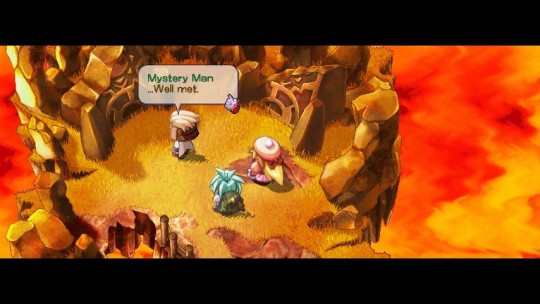
So what happens if you wait until after he’s unmasked himself, THEN hit up all the arcana paths in the dungeons?
Well, for one thing, his unmasking scene plays out quite a bit differently, since Pokkle and Pipiro will be meeting him for the very first time (a scene I had a lot of fun writing, particularly when Pipiro calls him “the living embodiment of stranger danger”). But then after that, when you proceed down the arcana paths, you’ll find no master awaiting you at all. Instead, you’ll simply find books! Books that give you electric shocks when you read them, teaching you the missing new arcana in the process (and leading to some pretty funny conversations between the two protagonists as they hold off touching the tingly tomes as long as possible, since they know just what’s coming when they finally give in – or rather, when Pokkle finally gives in, since Pipiro sure ain’t touchin’ that crap!).
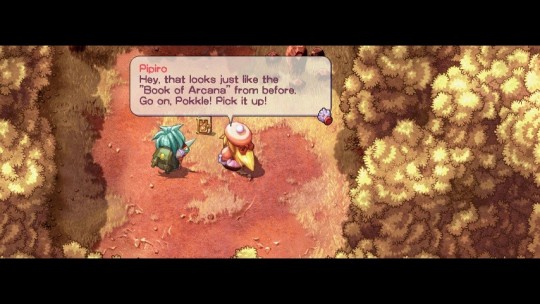
I love it when RPGs include that kind of attention to detail, and that’s really just one example of many. But there’s still more to discuss, too. Like the new stuff we added to fill in the gaps left behind by stuff we couldn’t quite include from the 2001 Japanese release.
See, in the original Japanese version of the game, there were three launcher apps you could unlock in addition to all the minigames: an alarm clock, a calculator, and a calendar. Matt (this game’s intrepid programmer, if you’ll recall) was originally going to port all three of these over into the final English version of the game, making them available to display on the HUD alongside the Pet Monitor, but he ran into some unexpected technical and logistical difficulties doing so. By the time he encountered these difficulties, he’d already successfully ported over the clock, but he was struggling with the calendar in particular.

Behold the glory of the Zwei clock! Also available in digital form – just click that little “A/D” button.
This was when we realized, there’s not really any use whatsoever for a calendar or calculator in-game. Like, at all. I mean, I guess the same could be said of an alarm clock, but at least theoretically, if you’re playing the game in full-screen and you’ve got a hot date later or something, you could set yourself a reminder alarm for when you want to save and quit so you can get ready. (I dunno! It’s plausible, right? Right?!)
So the calendar and calculator were disabled. RIP, outdated desktop apps!
…Except, hold on. It turns out there’s actually an optional boss in the game that you can only get to by unlocking the clock, calendar, and calculator. Yes, seriously.
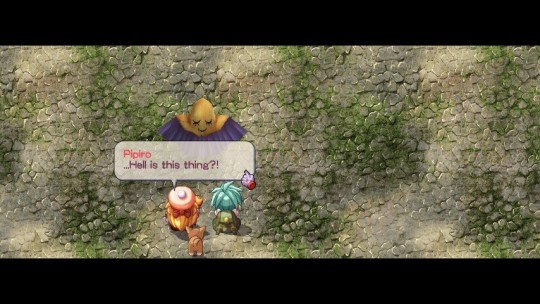
This means we had to replace the two missing apps with something else that could trip the same event flags. So I thought about it for a bit, and two new items were born: the “Clock Manual,” and the “Clock Warranty.” These two book items replace the calendar and calculator, and when used, they expand upon the lore of the clock (now the “Cursed Clock”), directly relating it back to the optional boss in question and giving tips on how and where to find him.
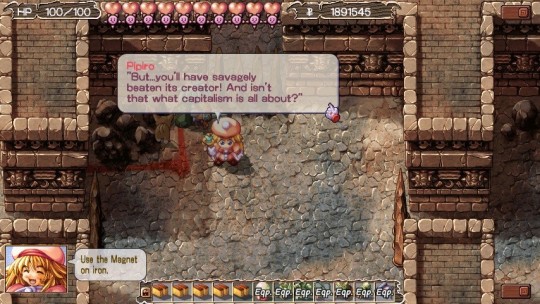
That’s not the only time we found that something in the game was more than meets the eye, though. Remember how in my previous blog, I said there was about two and a half games’ worth of text in the game’s files, including character backstories and plot arcs that were apparently cut from the final release? Well, some of that belonged to a hidden robot. And that particular text wasn’t quite as unused as I first thought.
We didn’t know this robot still existed in-game until we were deep into QA, but you have to find him in order to get one of the items necessary for 100% achievement completion on Steam or GOG Galaxy, so it was inevitable we’d come across him sooner or later. And while his original text unfortunately could not be included in the English version of the game as-is, the robot is still there, with a little bit of newly written text for your perusing enjoyment. And he still gives you one of the items you need in order to get all the achievements, so be sure to keep an eye out for him as you play! If you want to know where to find him… well, here’s a hint: this is the controller I switched to in order to accomplish the particular feat required to test his new dialogue.
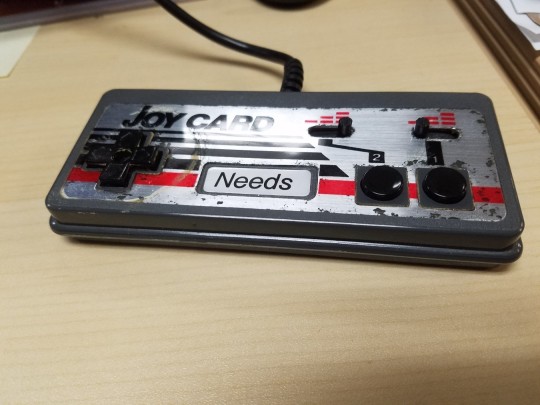
You could say it met my… needs.
You may not have to do the same. You may be a far more accomplished gamer than I. But for me, this was the best option I had, and it worked like a charm. (Plus, it was IMMENSELY SATISFYING to play Zwei: AA and achieve something noteworthy using an MSX controller… but that may just be the MSX enthusiast/gaming hipster in me talking!)
Anyway, speaking of finding very well-hidden things, this game also has 16 collectible “bromides” in it. Remember the bromides from Lunar? Yeah, they’re kind of like that, only… less naughty.
In fact, in the original Japanese, they were MUCH less naughty. Because they didn’t do anything. They were literally just collectible items that took up space in your inventory. Catch ‘em all, and you got… the satisfaction of knowing you caught ‘em all! Which is fine, of course, and certainly not without precedent – I’ve played many other games that have had similar collection elements in them – but we thought it was a little bit of a shame to have these items in the game without giving the player a chance to actually look at them. So… we contracted the same artist who drew all our achievement icons for both Zwei titles to draw full-sized images for all 16 bromides as well.
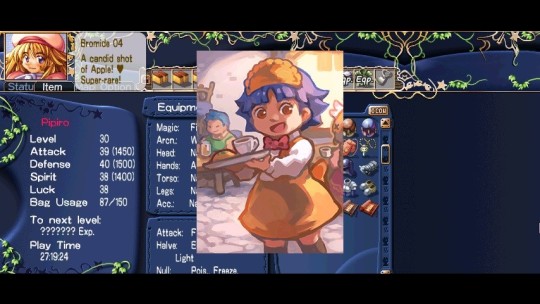
Yep. The bromide pictured here is one of the easier-to-find ones (though none are actually easy to find), but there are 15 more out there, just waiting to be seen! (And like this one, most of the others have secret cameos in them by characters from other Falcom titles, added with the full support and permission of Falcom themselves.)
We also hired an artist whom we’ve worked with in the past (on Ys: The Oath in Felghana and Ys Origin) to help expand some of the 4:3-resolution game areas and system screens to display in 16:9 without breaks in the art. Over time, his involvement grew, and he wound up designing a handful of tutorial images for us (since this game never previously had any in-game instructions or tutorials whatsoever, and is decidedly not intuitive enough to get away with that!). And boy oh boy, are these tutorials ever something special…

He also did a bunch of other stuff, including creating images for each of the status ailments, implementing virtually all our translated Japanese graphic text, and redoing the look of the arcade machines in “Undine Land” (you’ll find out about this place when you play) to better reflect the games contained within them.

Pretty nice, huh? Certainly makes The Typing of Ys feel a little more like it belongs in-universe!
So, yeah. This isn’t just a simple localization, nor is it really a port. It’s not quite an uprez, and it’s not quite a remake. It’s something altogether unique, and decidedly very special to us – to all of us who’ve involved ourselves with this game. It’s something we’ve poured our hearts and souls into, doing everything in our power to make it the best version of Zwei!! the world has ever seen, and to ensure you have a truly memorable and rewarding gaming experience when you play it. And we all hope very much that you do indeed love playing it as much as we loved working on it.
Be sure you don’t miss this one when it releases on January 24th.
(Oh, and check out the website, while you’re here. It’s pretty outstanding! Particularly that Characters section. Don’t think we’ve ever had something like that before on one of our sites, and it truly is something to behold!)
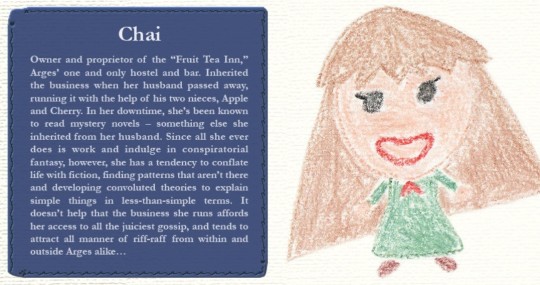
You can see the full roster at http://www.visitarges.com, along with a bevy of other information about the game!
Anyway, take care, future Zweiholics! May we meet again somewhere, someday, in the vast expanses of Granvallen!
37 notes
·
View notes
Text
Zwei: The Arges Adventure - Localization Blog #3
What time is it?
*enables the “Cursed Clock” app and checks*
That’s right! It’s time to talk some more about Zwei: The Arges Adventure!

We’ve already covered AAAAAHH I’M SO EXCITED and technical improvements, so now it’s time to move on to my old friend Pearce D. Resistance (nice guy; keeps to himself most of the time and does a lot of puzzles).
I speak, of course, of this game’s script and its many interesting quirks. And I’ve gotta say, it’s hard to even know where to begin here! So, I guess I’ll just start with the meat of the script: protagonists Pipiro and Pokkle. These two kids are the heart and soul of the game, so it was absolutely essential to get their personalities just right in translation. Fortunately, they’re two of the most uniquely charming characters I’ve ever written for.

See, localization is more than just looking up words and replacing them with exact equivalents (especially from Japanese to English, since the two languages have almost no similarities in their grammar or linguistic flow); so while the script was absolutely hilarious in Japanese, a word-for-word translation wouldn’t have conveyed nearly the same sense of over-the-top absurdity and delightful self-awareness that native Japanese-speakers were getting out of the original text. To do that, I had to kind of get into Pipiro and Pokkle’s headspace – I had to translate the Japanese to English, then think to myself, “How would this character naturally convey this idea in English?”
This proved both easy and fun for both characters, largely because they reminded me so strongly of people I know (or am) in real life. Pipiro, for example, is like an odd amalgamation of current coworker Jason and former coworker Kelly. Jason’s got the same direct manner of speaking and unwavering confidence as Pipiro, while Kelly’s got the same sense of streetwise savvy, similarly strong opinions about things, and a matching degree of unfiltered expressivism. Some of you may remember Kelly as our Twitter handler for several years (perhaps most renowned for her love of skeleton GIFs), or may know Jason as our in-house fighting game expert. If you know both of them, try to imagine what a fusion of the two would be like in video game form, and that’s Pipiro in a nutshell. No lingo is too hip or unhip for her to use, no statement too blunt, no promise too untenable, and no action too outlandish. She goes where she wants, says what she wants, does things how she wants, and is all the more fun because of it. I fully expected to prefer writing Pokkle when I started working on Zwei’s English script, but in the end, I found Pipiro’s dialogue far more rewarding, since she basically is the living embodiment of “saying what we’re all thinking,” oftentimes in quite clever ways – not to mention approaching everything in life with a critical eye, and never hesitating to share her true feelings with anyone and everyone. She is, simply put, my favorite character I’ve ever translated.

Pokkle, on the other hand, is basically me. Mixed with my coworker Nick. Largely because of all the puns. Now, some may worry that I took his puns a bit too far in the English version of the game, since he definitely busts out puns a bit more often than he did in the Japanese – but this wasn’t done simply because it was fun to write (although it most definitely was!). Rather, this was done in order to really sell his character to the audience. See, the reactions other NPCs have to Pokkle fall largely within the “groan, lecture him about his life choices, and/or tell him to get out” category, and these types of reactions are ones that I know all too well (as, I’m sure, does anyone else who has a predilection toward the “dadliest” of jokes). But the degree to which he punned in Japanese didn’t really seem to warrant the severity of the reactions he was receiving – not in translation, anyway. It felt like the rest of the town was being overly harsh toward him, sticking him with a reputation he hadn’t entirely earned. So, naturally… I made him earn it. I gave him a translation that I feel accurately represents what the original Japanese intended from him, accounting for the degree of punning required to truly become beloved yet reviled by the masses as a constant source of dad jokes that often stretch the very fabric of good sense.

I had to get into various eccentric headspaces for all the other characters too, of course, but there was another step required before that: simply figuring out who the hell was talking! The way the game’s text is structured, it was mostly easy to tell when Pokkle and Pipiro were speaking (though sometimes, as when examining objects in town, there was no real indication which line belonged to which character beyond the speech style of the Japanese), but other characters were either labeled as YOU or ETC throughout the script. Much of the time, there were comments in the code specifying to whom these YOU or ETC lines belonged – but this couldn’t always be counted on, since such comments were occasionally vague, incorrect, or missing altogether. This was definitely a game best translated while playing through it in Japanese.

Another good reason to do this? Figuring out what text is actually used, and what text is not. I’d estimate the script for Zwei: The Arges Adventure contains within it about two and a half games’ worth of text, including countless scenes that no longer exist, and even a whole other storyline with heretofore unseen characters, repurposed characters, and events and backstories that have absolutely no analogues whatsoever in the finished game. The legendary hero Paradys, for example, existed in some previous draft of the game as a noble military commander from the royal capital (which itself doesn’t really exist anymore in the game’s lore) named “Paradys du Pereau” – a name Pipiro had trouble remembering, so she decided she’d just call him “Perolin.” A lot of times, this was my first clue that the scene I was translating was unused, since there are no occurrences of the “Perolin” nickname (nor even Paradys’ last name) in the game’s final script whatsoever. (Or… Or ARE there?)

Paradys was also always accompanied by his trusty “hellcat” companion, which seems to have survived into the final version of Zwei as a boss character for the Pet Monitor minigame. Additionally, Paradys had a personal pilot named Silva, and Silva doesn’t seem to exist in the final version of the game in any form; instead, the game’s sole pilot role is filled by an NPC named Miles. And this is fine by me, as Miles has a lot more personality than Silva seemed to from the bits I got to read through – plus, again, anytime I encountered a scene featuring Silva, I immediately knew it was safe to skip over in translation, since it was clearly unused.

Perhaps these large swaths of unused text were part of the game back when it was known as “PiPiRoS PoCuRus” instead of “Zwei!!” – a name some clever Japanese fans found is still represented in the original version of the game, albeit only when triggering a glitch in the launcher.
So, yeah. Because of all the stuff that no longer exists in the finished game, this was a decidedly challenging yet endlessly interesting localization project. But then when you add in all the obscure stuff that was left in the game, it becomes an even more fascinating specimen!
That’ll have to be a story for next time, however, as this is already getting pretty long. But never fear, because we just announced the game’s launch date, and it’s less than two weeks away, on January 24th! Have you seen our launch date announcement trailer yet? It’s super-cute!
youtube
There will be one more blog entry about this game sometime before launch, but until then, Zweiholics, I bid you…

41 notes
·
View notes
Text
2017 End-of-the-Year Q&A Extravaganza Blog! #5
It’s time for our last Q&A blog of the year. It’s been a fun time answering all these questions--you guys had some seriously good ones!--but now it is time for us to chill out and celebrate 2018. Hopefully we can give you guys good reasons to celebrate 2018, too!
For our final Q&A blog, we have answers from:
Ken Berry, Executive Vice President / Team Leader John Wheeler, Assistant Localization Manager Ryan Graff, Localization Lead Liz Rita, QA Tester Nick Colucci, Localization Editor Brittany Avery, Localization Producer Thomas Lipschultz, Localization Producer

Question: Does working on a game affect your enjoyment of it in any way? Do you anticipate playing the full package after it is done or do you play through it beforehand anyway? Have you ever been spoiled on a game through work and if yes how severe was it? - @MizuUnNamed
Brittany: It definitely does. It's like the difference between babysitting a kid over the summer vs. giving birth to that kid and raising them till they leave the house. Even the most frustrating things about a game will somehow become something you love in a weird way, because it’s your kid and it's your responsibility to raise it right. When you're localizing a game, you're choosing every single word, and every single decision you make for that game will shape the experience for the thousands of people who play it. Characters I'd normally hate as a player become characters I love because figuring out their dialogue is a joy, and stuff I never thought about in localization are now very particular to me because I want my kid to go out into the world looking its best.
I will always play the games I work on. Sometimes I play them in Japanese beforehand, but there are days where I edit a file while playing line-by-line just so I can look at a character's expression and match the line written to the face. Then I replay it a few time as the English builds come in, tweaking it bit by bit, because it feels different to see the English on a sheet compared to seeing it in-game. It takes a ton of time, but I'd rather have a final product I can be proud of than to give up because something requires extra work.
Liz: When I started working here the first thing I tested was Corpse Party PC. I played it for like 200 hours and that game is much shorter than that haha. I loved every second of it, and recently got to test it again for the Linux + SteamOS release. Oh boy, that was a treat <3 I also got to work on Cold Steel II and at the time I didn't have the consoles the first released for, so I just watched playthroughs online... bless Cold Steel PC! I don't think I've ever been spoiled on a game through work before.... except maybe for Book of Shadows? But I don't even remember that spoiler so does it really count?
Nick: This is going to vary widely from person to person. For me...admittedly yes, working on a game does impact the enjoyment I’m able to derive from that game as a finished product. I understand, going in, that simply by virtue of working on a game, I will know its plot from beginning to end, see all the character development (including optional stuff that you might not even be able to view in a single playthrough), and in general become a subject matter expert on its world and lore. I’ll have knowledge of all the optional events and the items it’s possible to get – and sometimes, even a few that exist but were never implemented.
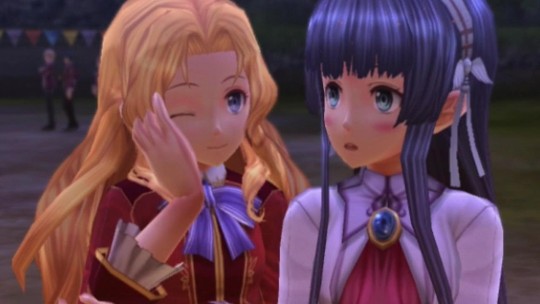
Working on a game is usually a months-long endeavor, during which we often end up playing the game in various stages of beta (or even alpha) readiness. We experience bugs we hope you never will; all the times text isn’t displaying correctly, voice or music isn’t playing right, or the battle system is falling over foaming at the mouth. By the time a game is ready to be sold, we’ve spent more time with it than would probably be considered healthy from a consumer perspective.
Outside of post-launch support/tweaking I’ve done for games like Zwei: The Ilvard Insurrection, I’ve never picked up a game I’ve worked on here after it launched. They’re good games, and I’ve been proud of each project I’ve worked on so far – it’s just that I’m someone with a low tolerance for repetition. You know – the sort who would get sick of even my favorite movies if I watched them every day for a week straight. As cool a game as Trails of Cold Steel might be, I’m in no hurry to sink 80 hours into an RPG that I focused all my attention on for the better part of an entire year.
While it IS perhaps a bit regrettable that I “ruin” my ability to enjoy a game in a normal-player context by working on them, I feel it’s a small price to pay if I can help deliver something that players will really enjoy their time with.
Question: When you brought over Rune Factory 4 to Europe, what difficulties did you encounter? How was the process? - @Marower
Brittany: Hey! This is perfect for me! We really wanted to bring RF4 to Europe, but with the developer now shut down, it wasn't possible. We spent ages looking for a programming team who would be willing to help us that also had Marvelous Japan’s blessing, and then it became my little pet project. I had zero experience with the process, so it was a lot of learning and guidance from my boss, Ken. We were able to update the text a bit to fix typos, but because we would never be as familiar with it as the original team, we wanted to touch the game's code as little as possible since we didn't want to risk breaking the game.

I tried to reproduce this one rare bug that causes the game to crash at the end of arc 2 (this is present in the Japanese, too, so it wasn't introduced in English), but it was impossible. I started the EU version from scratch and went up to that point. There were rumors that soft resetting the game caused the issue since it really wasn't programmed to handle soft resets too much, so I did that as often as I could. Nothing. Oh, man... I wish I could've found the pattern that caused such a weird crash. It's rare, but no one wants a crash in their game.
NA only has one rating, but Europe requires several different ratings, so that's an interesting process. The store pages all require various languages, too, depending on the region. I learned that because you could palette-swap character models to simulate gay marriage that the game had to be 18+ in Russia. 18+! For a Rune Factory game! All of the processes take a bit longer, but it was mostly a lot of communication, paperwork, confirmations and such. All worth it to finally get that game out there!
Question: What process leads to additional content in localized releases? Things like additional voices for Trails of Cold Steel on PC. How do you decide which titles get "a little bit extra"? - @Baust528
Brittany:
Me (messaging programmer on Skype: hey are you up Sara (programmer): Yeah. What's up? Me: lmao wouldn't it be awesome if we could put x in the game Sara (ten minutes later): It's in the game.
That happens a lot. As a more serious answer, since we try to localize games we're personally passionate about, it's easy for us to see what we'd want as a fan, too. So we'll sit around and go, "Wouldn't this feature be nice?", and we'll see if it's doable. If it is, we'll do it.
The extra voice acting in Cold Steel PC came about because we wanted to do it for PS3/Vita, but it wasn't possible. I asked if we could put the games on PC one day, the boss worked out the numbers, and we realized that avenue was perfectly possible. We thought adding new voices would be great, because the English cast was very well received in English. Turbo Mode and ultra widescreen were both Durante, though. Those were awesome.
Generally, if our programmers have an idea they'd like to add to the game, we allow it. They're programmers! They know if it's possible, and if it makes the game better, who are we to say no? That's how the Sky games have gotten so many improvements over the years, too. We're incredibly fortunate to have Sara as a programmer, because she takes each project very personally and still finds ways to improve them years after launch.
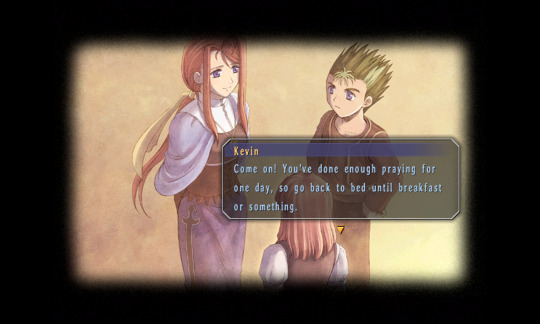
Tom: There are a lot of factors that go into things like this, but one that's come up a couple times now has definitely been our inability to license the Japanese voices. We figured, if we can't offer dual voice to players, why not use whatever budget we may have set aside for that to give them something a little extra? It may not be exactly what they want, but it's at least something we can offer them to show that we truly did put our best foot forward with this release
Nick: As weird as it may sound, it starts with just someone asking, “Hey, could we do this?” Sometimes, what we’ll want to do is evident due to what’s perceived as a shortcoming in a game. Trails of Cold Steel had a lot of voice acting, but weirdly left protagonist Rean silent in a number of scenes where all the other characters were voiced. That was the initial impetus for us wanting to get back into the studio for the PC release and record all the voicework we couldn’t for the PS3 release (in which we could only supply voices for lines that were voiced in the Japanese version).
Similarly, when I was planning out the recording for Zwei: The Ilvard Insurrection, I thought, “We’re having people in to record these battle voices and we’re gonna pay them a minimum session fee anyway, so...why not add some story scenes onto that?” So in the end, we managed to include a solid amount of voice acting in there for a game that, in its original version, had very little.
Question: Have you ever considered localizing otome games? It would be nice if you can bring us some handsome boys. (*^^*) - @NymphNayade
Brittany: Hmm.
Question: Can you comment on the difficulty in trying to get Japanese developers to support same-sex couples/marriage in games like Story of Season or Rune Factory? - @atelier_michi
Brittany: XSEED's always been very openly supportive of adding that. I don't know what difficulties there would be in Japan, but I try to think of how much progress we've made to be able to openly ask for same-sex couples/marriage in games. It wasn't long ago that the idea was ludicrous. I remember when Ellen DeGeneres came out in the '90s and it affected me very strongly, especially since my parents would actively tell me, “Adam and Eve, not Adam and Steve.” So even if it's not in the current SoS games, I'll ask for the feature every time I visit Japan, because I think being open about it is an important factor to making progress on that front. Nothing will happen if you don’t fight for it.
I'd really like a whole variety of relationships in the SoS. Gays, lesbians, bisexuals, pansexuals, or even a unique relationship outside of sexuality like dating a single parent or supporting your partner as they transition. It's that sort of variety that makes life interesting and great, and I think introducing these concepts in a series as darling as SoS normalizes them and helps children to perceive them as innocently as heterosexual relationships and concepts. It's very educational. Normalizing it more would teach people to ask more questions, too, instead of rejecting any type of orientation or relationship that seems foreign to them.
I remember for the first SoS game we published, Hashimoto-san said he had animals die in the game because he wanted children to be introduced to the natural process of life and death. It wasn't meant to be a bad thing, but something we should be comfortable with because that's part of what it means to be alive. Something to that, lol. Anyway, I'd like for just as much heart to be taken to represent more kinds of people in life, too.
Question: A rumor is going around that you guys are avoiding publishing fanservicey games outside of Senran Kagura. This came in wake of you guys seemingly passing on Valkyrie Drive. Is there any validity to this rumor, and if so, why? - @WaywardChili11
Brittany: did people forget we did a game with literal strawberries and a banana as a costume
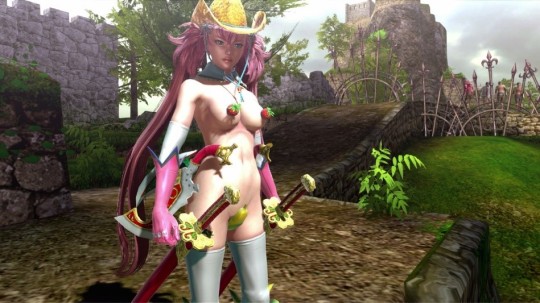
That's a weird rumor. It’s also dumb. We've done fanservice games in the past, and we'll decide on whether or not to do them on a game-by-game basis. We're not necessarily passing on them because of fanservice, but I also don't think fanservice is core to the XSEED brand, so it shouldn't be a given for us to do fanservice titles just because we’ve done them in the past. Many of us enjoyed Onechanbara and we have some SENRAN KAGURA fans in the office, so we published those because we originally liked them as games that happened to contain fanservice.
We’re also not big on censoring games, so I’d rather pass on a game than work on it after it’s been censored. If I were to localize a title and actually choose to censor it, I’d piss of people who don’t like the fanservice content, I’d piss off the people who want that content, and then I’d be pissed off because if I felt something was so horrible that it needed to be censored, then I probably didn’t want to work on the game.
That doesn’t mean every fanservice game is off the table for me, but I would need to evaluate it to see if the game is for me, as I would any other genre. Like, Lord of Magna is overall a super-cute game, but it also has an out-of-nowhere hot springs scene. I felt that scene detracted from the game because the rest of the game was adorable and innocent. That said, I didn’t remove the scene, and I still loved working the game. It’s a game with fanservice I would still happily play again.
Meanwhile, SENRAN KAGURA sells on fanservice, but the gameplay is pretty good. I admit that I prefer the older titles for DS/3DS which were more ridiculous titillation with a good story than the more overt modern titles, but again, that just means the series is no longer for me, and that’s fine. We still have SK fans in the office, and they enjoy working on the series.
Another factor is gaming trends and our overall rep as a company. Fanservice games weren’t always as hot as they are now, and XSEED started off with a variety of genres, with our niche eventually falling to RPGs and such. Every trend has a rise and fall, and if we pick up every fanservice game regardless of quality just because it’s hot now, we’re alienating the audiences that love us for action, RPGs, and so on. We may even alienate retailers or future marketing opportunities for the games we license outside of that genre. We’ll have shot ourselves in the foot if the fanservice trend falls when we made it our bread and butter. I like having a job.
Tom: We certainly don't have any problems with fanservice, as I think we've proven quite thoroughly at this point. But we also don't ever back a game simply BECAUSE of its fanservice. When we release a game, we do so because (1) we like it, and/or (2) we see some really good potential in it. If it happens to have fanservice, great! If not, also great.
On the flipside, we also turn down games for a variety of reasons. Maybe we hated the story. Maybe we hated the gameplay. Maybe we felt it took its themes a bit too far, or that it had a lot of wasted potential that it never quite lived up to. Maybe we put in an offer on it but were outbid, or the developer appended unusual terms to the license that we weren't willing or able to accept. Maybe the developer simply didn't want to work with us for some reason, or we didn't want to work with them. Maybe we didn't have time to work on that title, or maybe we simply felt someone else would be able to do a better job with it. Tl;dr version, there are a LOT of factors that go into licensing decisions!
Our reasons for turning down a game aren't really something we can ever outright tell you guys, due to the NDAs we all signed when we got hired. But suffice it to say, it's never simply because of fanservice. Fanservice may potentially contribute to a larger tapestry of reasons for passing on a title in extreme cases (though they'd have to be pretty extreme!), but rest assured, we'll never say no to a game simply because it shows a lot of skin. Good games are more than skin deep, after all!
Nick: Here’s the Nick take: Most of us here don’t mind fanservice. It’s fun, it’s saucy, and folks can have a good time with it. If you look at our lineup, you can see we don’t shy away from games that have fanservice (Oneechanbara!), and games that push the boundaries, as Senran Kagura sometimes does, certainly aren’t out of the realm of consideration. A boob, a bulge; it’s all fair game here.

But here’s the thing. The games a company releases become part of their oeuvre. We have a reputation for quirky Japanese games because we’ve released enough of them that it’s a noticeable trend. The same would happen if we opened our gates to every fanservice-laden game that came knocking. Speaking personally, I don’t want us to have a reputation as a publisher whose stock in trade is mainly cheesecakey fanservice or smutty games. That kind of pigeonholing doesn’t help us as a company, and at worst, might even preclude some future licensing opportunities.
I think a lot of people get the impression that we turn down fanservice-laden games for some sort of censorious or moral reason, but that’s not especially true. There ARE cases where we might think, “If we licensed this, the ESRB wouldn’t let it through without forcing us to censor enough that the primary audience we were licensing it for in the first place would be upset,” and there are times when a game might simply be in bad taste and we decide we don’t like how it handles sexuality.
Sometimes, iffy material gets through in spite of all that. The SENRAN KAGURA series has done well for us, so we continue to publish those games even though a number of us in the office have concerns about how each new game seems to push the boundaries further and further in terms of what’s allowable (either by the ESRB or by common decency). We keep a close watch on that, and we’ve communicated our feelings to Takaki-san and his team. We strongly dislike having to alter content in this way, so if a game is so stridently sexual that we think we’d probably be forced to do so by the ESRB (as was a going concern with Valkyrie Drive, iirc), that factors into our decision-making process.
More often, the mundane truth is that we’ll turn down a game of this type because our evaluation play-tests show it to not be very fun to play. It’s not uncommon for games in this vein to just focus on piquing prurient interests or trading in tawdry titillation while the actual game underneath feels janky to play, or has no depth once you get past ogling your favorite waifu. That’s something that can’t be conveyed through a screenshot or even game video, which leaves hopeful players confusedly thinking we passed on a game for reasons more related to its content.
There’s a solid balance to be struck between acknowledging and publishing content for a mature audience and turning down projects that don’t jive with us, and I want you guys to know that we DO put a lot of thought into keeping this balance healthy.
Ken: When we first published SENRAN KAGURA Burst in late 2013, it was a much stricter retail environment so we had to approach the title with caution. We needed to see if there was a market for the series in the West, and even if there was the absolute worst thing that could happen would be to start manufacturing only to hear that retailers suddenly don't want them or want to return their units because of a complaint they got. Due to the success of the digital-only release of SENRAN KAGURA Burst we were able to release the next few games in the series physically at retail (so the "no physical no buy" people really need to thank their digital-buying colleagues), but that doesn't mean that we get a free pass to release anything in the future. As each new iteration seems to push the envelope further and further, we need to be careful exactly how far we push - at some point if we push too far and the whole levee breaks, it could have repercussions for games that have already previously been released.
Question: Who is best girl and boy? - @MizuUnNamed
Brittany: Can I get Crow Armbrust and Crow Armbrust for $500?
Tom: Narcia and Pietro, of course. But only for each other.
Liz: Rottytops and Ludus! What did we do to deserve them?
That’s all, folks! It’s been a wild ride, but hopefully we answered your questions well enough.
54 notes
·
View notes
Text
2017 End-of-the-Year Q&A Extravaganza Blog! #4
It’s that time again! Our fourth 2017 End-of-the-Year Q&A Extravaganza is here! I lied about there being more next week in the last blog, because it is clearly still this week. This time, we have some answers from:
John Wheeler, Assistant Localization Manager Ryan Graff, Localization Lead Nick Colucci, Localization Editor Brittany Avery, Localization Producer Thomas Lipschultz, Localization Producer

Question: Is XSEED responsible for inserting the voice and text to a localized game or is this done by the Japanese counterpart? If it is the latter, how do you ensure integration works seamlessly―especially working on translation without looking at the game play? - @Sugoi_Lang
Tom: Typically for console titles, it's the developer who actually inserts the text and voices (we just supply the files), while for PC titles, it's all us. There are exceptions to this, though.
Either way, there's no way to ensure the text and voices are seamlessly integrated without playing the game after they've been implemented, and that's a big part of the reason why there's always a lengthy QA period between the completion of a game's localization and its release: we need to make sure everything fits in the space available, all the right voices are being played at the right times (and match the text perfectly, since we don't like when there's different wording used in the text box than what players will be hearing spoken), etc. Invariably, we'll get a new build of the game every few days (or at least once per week) during QA, constantly tweaking things until the very end.
Question: How soon will XSEED reveal a game which is currently in the process of localization to the general public ? - @Sugoi_Lang
Brittany: This depends on the game. We used to announce titles pretty early into localization, but then something unexpected would happen and it'd push the game back, and it makes it look like we're taking too long on something to fans when the unexpected is really par for the course in this industry. But if we keep quiet about it and privately deal with those problems before announcing anything, then it looks like we're working really fast. I prefer that method.
Question: Does a localization company like XSEED provide active feedback to their Japanese counterpart on the games they release for improvements, or is this a one-way process? - @Sugoi_Lang
Brittany: If we evaluate a game, we'll provide feedback on what we liked or things we'd like to see improved. Whether these changes go through depends on the schedule of the devs, the potential of the title, and a bunch of other stuff.
I was super happy when Falcom changed a certain part of Cold Steel II's ending for the English audience (trying to avoid spoilers here). I proposed it well in advance thinking they wouldn't accept, but they seemed so happy with the idea that they went above and beyond for it. I didn't know they gave us exclusive content until the build came in, and I had to tell them how excited I was when I saw it as a fan. It also received tons of positive feedback from not only English Trails fans, but Japanese, Korean, and Chinese fans as well.
Edit for clarification: If you’ve beaten CS2, look up the difference between the Finale credits in the Japanese and English versions of the game. That’s the change. -- Brittany
Another great example was in Akiba's Trip: Undead & Undressed. It's a game about stripping vampires, and it's less sexy and more ridiculous. However, when you fought female bosses and they were stripped, they had an over-the-top sexy portrait while male bosses had nothing. We asked the devs if they would consider adding sexy portraits for the male bosses, too, and they got the original game’s artist to draw them for us. It was such an awesome thing to see our feedback taken so seriously.

Tom: We provide feedback all the time, particularly when we're working on a game that's still in development. And although our feedback isn't always taken, it does sometimes result in some considerable improvements to the gameplay experience -- like the inclusion of an encounter rate slider and King difficulty in Return to PopoloCrois, or the inclusion of male strip portraits in Akiba's Trip. When we're working on PC titles especially, we have a direct line to the programmer(s), and can thus add all manner of improvements, such as turbo mode in Trails of Cold Steel, or... well, an entire blog's worth of quality-of-life improvements in Zwei: The Arges Adventure (see this blog for further information!).
Nick: It’s worth noting that due to developer production schedules, it’s often hard to get suggestions implemented in already-finished console versions of games, versus when we’re doing PC ports, where our programmers are more often than not up to the task of adding features or making improvements, within reason.
Ryan: Some developers are young and eager, with their games still in progress as they work with us; others are set in their ways, or have already finished every other version of the game by the time they send it our way. We do our best to pass along suggestions, though, both from ourselves and from our fans, for possible improvements to be made in future patches/sequels. For example, we got a lot of fan feedback saying that the cutscene text in Peach Beach Splash was difficult to read, so we passed that along to the developer, and they added a darker backdrop to that text in the latest patch.
Question: Is there any game/franchise you want to work on personally, no matter how impossible? - @MizuUnNamed
Brittany: E.X. Troopers and Dai Gyakuten Saiban. E.X. Troopers is baller as hell, and Ace Attorney is one of my favorite series. I don’t think my editing could live up to the current AA localization team, though, so if anything, I’d want to work with them to see to it the game is up to their standards of quality. Please @ me, Capcom.
Tom: La-Mulana, Owlboy, Freedom Planet, Ghost 1.0, Goonies, Sorcerian, Dinosaur, Popful Mail, more PopoloCrois, more Brandish... I could go on, but basically, awesome retro-styled indie titles, classic Falcom, PopoloCrois, and the Goonies franchise are my dreams.
Also, it's no secret at this point that I've become a full-on gaming hipster and been playing a ton of games for the MSX line of Japanese computers over these past three years, and I keep hoping I can one day convince management to let us release an MSX collection of some sort. Maybe old Falcom games (Xanadu, Romancia, and Dragon Slayer IV/Legacy of the Wizard?), or a collection of titles from Konami, or T&E Soft, or Compile. Or even some of the mid-'90s European homebrew games. Tons of great options, almost all of them ridiculously unlikely to ever happen! ;)
John: I never thought I'd end up in this industry, let alone working on a series as important to me as Bokujo Monogatari/STORY OF SEASONS. I feel very lucky to be a part of it.
Nick: No matter how impossible? Well...as a longtime enthusiast of the Suikoden games and their long-running, interconnected storyline, I’ve always dearly wished I could work on a new mainline-series entry (or somehow go back and re-localize some of the earlier games). As things stand, though, this is basically just a feverish pipe dream. My co-worker Ryan actually got to help with editing on Suikoden V back when he worked at Konami, and I’m jealous! That world and those stories are begging for a rich, textured localization effort, and I would work at the peak of my powers to bring its mysteries to life. Be on the lookout for my and Jess’s x-treme bake sale to raise money to buy the rights to the series. :P
Moving into the realm of “at least technically possible,” I think everyone in the office knows that I’d absolutely jump at the chance to work on a Vanillaware title. Being able to collaborate with Kamitani-san and his crew and pen the English script that would bring one of the studio’s beautifully-realized worlds to life would be one of those career-defining milestones for me. I’ve been a huge fan of the studio and their aesthetic for years, and I’d like to think I’ve become a skillful enough editor to do one of their games justice.
Thirdly, I’d really enjoy being able to work on a new Wild Arms game. Does anyone know what’s going on with that series? I don’t know, but if Media Vision decides they want to do Wild Arms 6 someday, I hope they remember the stout-hearted publisher who released Wild Arms 4, 5, and Crossfire in the West. When it comes to a sci-fi fantasy RPG where people wield magical guns, trust in our rootin’, tootin’ American sensibilities to bring you the very best in fanciful firearms.
Ryan: I’ve mentioned this once or twice before, but there’s an old Super Famicom RPG, published by Enix, called Dark Half, in which the player spends half the game playing as the heroic knight out to stop the devil, and the other half playing as the devil. It’s had a fan translation already, but I’d love a chance to sit down and work on it myself, just to bring such a unique game to more people.
Question: Whose idea was it to cake Rean, and did you already have that speech ready or did you specifically request it for that event? - @MizuUnNamed
Brittany: I messaged Rean’s VA with the following and he got back to me with the audio literally two minutes later:

Our next blog, blog #5, will answer:
- Does working on a game affect your enjoyment of it in any way? Do you anticipate playing the full package after it is done or do you play through it beforehand anyway? Have you ever been spoiled on a game through work and if yes how severe was it? - When you brought over Rune Factory 4 to Europe, what difficulties did you encounter? How was the process? - What process leads to additional content in localized releases? Things like additional voices for Trails of Cold Steel on PC. How do you decide which titles get "a little bit extra"? - Have you ever considered localizing otome games? It would be nice if you can bring us some handsome boys.
See you next time!
27 notes
·
View notes
Text
2017 End-of-the-Year Q&A Extravaganza Blog! #3
Happy Holidays! It’s Christmas for those who are down for Santa, and we have a gift for you! (It’s also a gift for those who aren’t down with Santa. You know what I mean.) Our third 2017 End-of-the-Year Q&A Extravaganza is here! There will be more next week, but for now, we have some answers from:
Ken Berry, Executive Vice President & Team Leader John Wheeler, Assistant Localization Manager Ryan Graff, Localization Lead Liz Rita, QA Tester Brittany Avery, Localization Producer Thomas Lipschultz, Localization Producer

One of our icons for Trails of Cold Steel II PC, coming in 2018
Now, on to the questions!
Question: Ever consider making a podcast/commentary for one of your games? My favorite Twitch stream from XSEED was the Trails in the Sky the 3rd stream followed by Xanadu Next. - @mhee123D
Brittany: I think our social media presence overall has been something we've struggled with recently due to lack of resources, but it's something we've been trying to figure out more with hopes of improving vastly in the future. The word-of-mouth approach we've been dependent on in our early days is becoming more and more difficult to rely on. Good method for baby companies, not so much companies like us in that awkward teenage phase. We've tried Twitch streaming, blogs, and our E3 presence was lovely this year. We're still working on it so that we can do right by our titles. Dunno if podcasting in particular could work for us, but who knows?
Liz: I'm not sure if anyone has the bandwidth to consistently produce podcasts here, but we've been considering a couple different streaming plans for the future. Full extended playthroughs of one game, charity streams, and some other stuff. Still working through feasibility with our schedules and such.

Question: The PC port diary thing from CS PC was fantastic. I really liked a kind of…behind the curtain look at what goes into a PC port. (I'd be similarly curious for the localization process overall.) Do you plan on doing more of those for future games? - @Halvard101
John: We love developer blogs too, but programmers are so busy that sometimes it can be hard to ask for them. Hopefully Durante will provide behind-the-scenes looks at his work on Trails of Cold Steel II. (Actually, he already has)
Question: What are the requirements/makes it likely to get hired as a translator? Would self-taught people stand a chance? - @Unironic_Weeb
Tom: Applicants are given a custom-made translation or editing test, and much of their qualification for working here is based upon that. I actually helped write our current editing test, and my contribution was basically to throw in tons of misdirection and overly harsh worst-case scenarios designed to make virtually anyone slip up. To date, I don't think anyone has ever really "passed" this editing test, though a few have come close (and some of them now work here!). So yeah, self-taught people absolutely stand a chance -- but be forewarned, as our tests are brutal, and if your skills aren't up to snuff, you're going to be toast. ;)
John: Absolutely. Where you learned Japanese doesn't matter as much as what experience you can prove with your resume. Showing us that you have experience is more important than seeing a degree. If your resume passes the eye test, then you'll really have a chance to show your might with our translation test.

As for other qualifications, I recently had a discussion with other members of our industry about the JLPT. While I consider N1 to be a good indicator of a certain level of Japanese proficiency, others were arguing that the JLPT as a whole is effectively useless as a measure of Japanese proficiency in a professional environment, so there's a wide range of opinions on that particular qualification. At the end of the day we only really care about your actual translation/writing skills.
Question: Are there any games you've worked on in the past that you wish you could go back to and do differently a second time around? - @TJ
Brittany: Trails in the Sky SC. Time management was nearly impossible for that one, so I'd give anything to go back and polish it further. But since we grow with each project, even when we’re proud of the end result, we’ll always find something that we wish we could fix.
Ken: Hard to say, but an example that comes to mind would be the disappointing sales of Fishing Resort on Wii. We thought it was by far the best fishing game ever made, but we just couldn't get any of the major retailers to stock it because they were choosing the competing fishing games that had well-known fishing licenses attached to them. We had plenty of critically-acclaimed titles like Retro Game Challenge and Half-Minute Hero that sold poorly, but Fishing Resort was the one title with mass appeal that really felt like it could have taken off if only it was given a chance at retail, especially considering that it was only $19.99 for the standalone game and $29.99 bundled with a high-qualify fishing rod peripheral. Maybe we should have paid some money to license a fishing brand that people had heard of, but who knows if that would have worked or even how we would have incorporated it into the game last minute.

Ryan: I worked on the English text for Castlevania: Dracula X Chronicles, including the re-localization of Symphony of the Night. There are parts of it I’m still happy with, but if I could do it again, I’d leave the whole “Die, monster!” scene alone. The consensus at the time, as far as I could see, was that the original translation was cheesy, but I misunderstood how many people loved it regardless.
Question: What does the first day of a new project look like? What kinds of things are done right off the bat? - @Baust528
Brittany: Weirdly, it never really feels like there is a "first day" for a project. Sometimes we know about a project's existence a year or more in advance, so it's just a long waiting game. There are even times where we have the rights to a project, but we only receive things directly required for localization as they're finished, so we learn of certain features or see artwork for the first time in official press releases with the public. So a weird answer to this from my perspective is that there is no first day.
Our blog later this week will answer questions like:
- Is XSEED responsible for inserting the voice and text to a localized game or is this done by the Japanese counterpart? If it is the latter, how do you ensure integration works seamlessly―especially working on translation without looking at the game play?
- How soon will XSEED reveal a game which is currently in the process of localization to the general public ?
- Does a localization company like XSEED provide active feedback to their Japanese counterpart on the games they release for improvements, or is this a one-way process?
- Is there any game/franchise you want to work on personally, no matter how impossible?
See you next time!!!
41 notes
·
View notes
Text
2017 End-of-the-Year Q&A Extravaganza Blog! #2
Our second 2017 End-of-the-Year Q&A Extravaganza is here! There will be more next week, but for now, we have some answers from:
Ken Berry, Executive Vice President / Team Leader John Wheeler, Assistant Localization Manager Nick Colucci, Localization Editor Brittany Avery, Localization Producer Thomas Lipschultz, Localization Producer
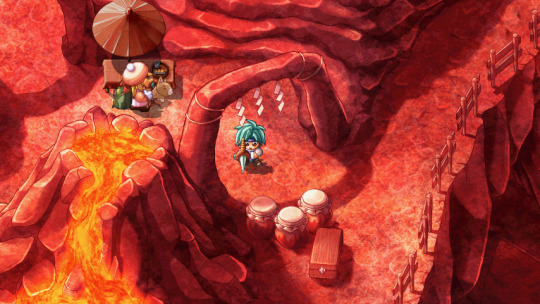
Question: Have you ever considered selling the music CDs for your licenses stateside? - @LimitTimeGamer
Ken: That's not really a business we're looking to get into, with the exception being when we've already printed soundtracks as part of a limited edition release and have some leftover. Music licenses are always tricky, and even if the publisher we licensed the game from completely owns their own music rights, they can self-publish digitally on iTunes worldwide so no need for us to get involved.
Question: If possible, would you please consider researching and localizing classic Korean-made PC xRPGs? & Do you have any interest in pursuing the localization of any of the large, beautiful Chinese RPGs that have been hitting Steam? Or are you focused exclusively on Japanese titles? - @DragEnRegalia & @TheDanaAddams
Brittany: The main reason we focus on JP > EN is because we're mainly an office of Japanese to English speakers, and we can verify the quality. We haven't completely ruled out the idea of other languages in the future, but we can't do anything to guarantee these games will be accurate yet. If we hired a person to localize games into a specific language, there's no checks-and-balances system in place for us to know we're investing in a project people will be happy to play because it's the best quality we can offer. Personally, I would hesitate to expand outside of JP > EN localization regularly until we've gained more experience as a company.
We've done a few instances of EN > FIGS, but since our games usually are very text heavy, even this is difficult. I would want to experiment with smaller games first. Hopefully, there will come a time when we can expand beyond JP > EN on a regular basis, since I’ve noticed some badass-looking games outside of the EN/JP languages. I also like the Korean developer Cheritz, who did Mystic Messenger. Jaehee will always be the love of my life.
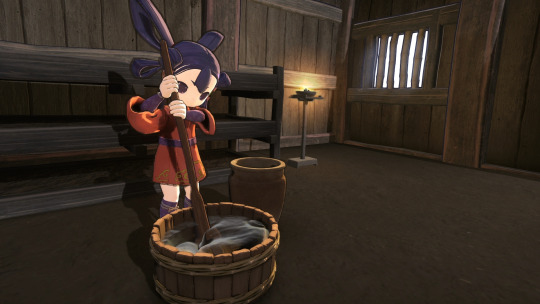
Ken: We are definitely looking to expand where we source games from in the future and not just limiting ourselves to Japan. Definitely lots of good stuff coming out of China, Korea, and other parts of Southeast Asia these days, and we're big fans of Western indie games too. You will be seeing a lot more variety of games from us in the future, but that doesn't mean that we'll be giving up on our staple of games from Japan - they will be in addition to those.
Nick: I figured I’d field these not because I have any special ability to get XSEED to license a game (we’re all free to suggest games for consideration, which is pretty cool), but because prior to working at XSEED, I actually did localization for Korean and Chinese F2P MMOs.
There’s a lot of game dev talent in places like China, Korea, and Taiwan that we in the west are only tangentially aware of due to their games market being significantly different from ours. To generalize a bit, outside of Japan, Asia doesn’t have a strong lineage of console development, as existing consoles haven’t been widely available in most of those countries. Rather, PCs are where people in Asia play their games – online games in particular, with net cafes being popular places to log in and play.
One of the first bits of localization work I ever did in my career was for the F2P MMO Dream of Mirror Online, for which I handled seasonal quests and ongoing localization (the base game had already been localized before I got there). The developer of that game, Softstar, has a cool, long-running Wuxia fantasy RPG series in China known as Xuan Yuan Jian, one installment of which is available on Steam right now. Wouldn’t it be cool to release an anime-style wuxia adventure RPG here? As a fan of drama, martial arts, and sweet swordfights, it would be pretty rad.
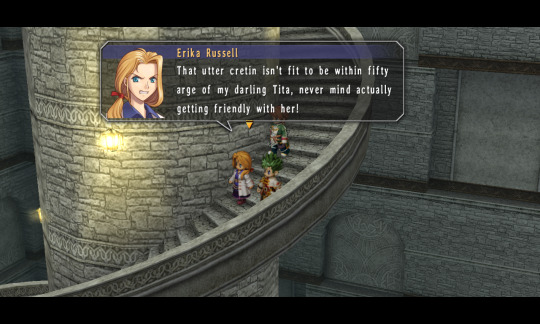
Personally, I’m totally up for dipping our toes into games like this as a company, but there are some extra challenges to taking on Chinese or Korean games that we haven’t had to contend with during our work on Japanese titles.
Perhaps most important is establishing audience interest in these titles. Even if we find cool Chinese or Korean games (and I’m sure we could), if we don’t sense a market demand for those games, it doesn’t make sense to expend the effort to publish them. That’s not a statement on their quality; it’s an issue of market awareness. Japanese gaming has an advantage for us, in a sense, in that it’s been pervasive in Western culture long enough that the names, language, and even history of Japan seem less strange and foreign to Westerners now than they were 20-30 years ago. We’ve come to have a taste for Japanese games and culture, one could say. That sort of natural predilection doesn’t currently exist for games from elsewhere in Asia. I think that a good game’s quality will be self-evident enough that it can become well known, but it would take considerably more work to make people aware of and interested in a cool game from China, Korea, Taiwan, Vietnam, or elsewhere than it would if that game were from Japan. And given that XSEED’s marketing and advertising resources are admittedly smaller than we wish they were, licensing and localizing a cool Asian game for a Steam release could prove difficult if we couldn’t connect the game with enough of an audience that would appreciate it. Before you nay-say me, look around at the amount of Chinese or Korean games currently available in the Western market that aren’t MMOs or mobile games. It’s...not very many, is it?
Not to say we’re not interested, of course! There’s a huge amount of potential in games from Asian developers, and an ocean of possibilities to explore. But I think, before that happens, we have to either find a game we think would be a pretty sure thing our fans would enjoy, or see that there’s a demand here for these games. If you’re interested in seeing XSEED work on Chinese or Korean games, do feel free to write us, especially if you have suggestions of titles you think are particularly worth checking out or that you think are very “on-brand” for XSEED.
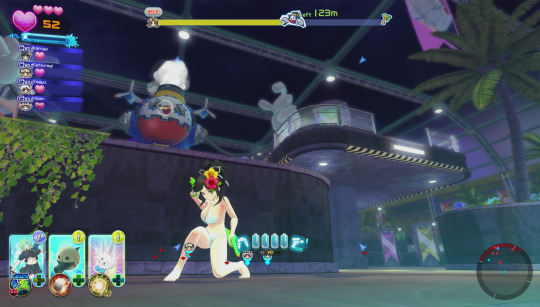
Question: What inspired you all to do this kind of work in the first place? Also, what is the story behind the company name XSEED? How did you all come up with it? - @TBlock_02
Ken: The company was founded by former members of Square Enix USA, including its president at the time, Jun Iwasaki. Other smaller Japanese companies would often ask him to publish their games in the West, and even though we came extremely close to starting a separate "Square Selections" publishing brand to distinguish our own titles from third-party titles, we were always just too busy working on Square Enix titles to have the resources to work on anybody else's. Once the new company was formed and the name finalized (we wanted our new business to grow and foster from an initial small "seed"), it was only natural to reach back out to the publishers in Japan who needed a way to release their games in the West.
Question: What was everyone's favorite game(s) to work on this year? - @ArtistofLegacy
Brittany: Trails in the Sky the 3rd. I was very emotionally connected to that game, and its text is something I think I'll be proud of for years to come.
Tom: Zwei: The Arges Adventure, hands down. Most fun I've ever had translating anything.
John: I had a lot of fun with the PR-side of STORY OF SEASONS: Trio of Towns (the Capy comics and marriage candidate intros), though significantly less fun with QA for the DLC.

Question: What's everyone's favorite song from the Falcom games you've released so far? - @Crippeh
Brittany: Can’t choose a legit favorite, but it took me, like, twelve hours to beat the Finale dungeon in Trails of Cold Steel II and I still listen to Phantasmal Blaze regularly.
Tom: I'm actually not a big fan of the Trails games (blasphemy, I know!), but I absolutely adore "Cry For Me, Cry For You" from Trails 3rd. One of my favorite Falcom vocal themes of all time. As far as non-vocal themes go, I've always had a soft spot for "The Depth Napishtim" from Ys VI, "Harlech" from Xanadu Next, "Casino" from Brandish: The Dark Revenant, and basically the whole soundtrack to Zwei: The Arges Adventure.
That’s it for now! Next week, we’ll be answering questions like:
- Ever consider making a podcast/commentary for one of your games? My favorite Twitch stream from XSEED was the Trails in the Sky the 3rd stream followed by Xanadu Next. - The PC port diary thing from CS PC was fantastic. I really liked a kind of…behind the curtain look at what goes into a PC port. (I'd be similarly curious for the localization process overall.) Do you plan on doing more of those for future games? - What are the requirements/makes it likely to get hired as a translator? Would self-taught people stand a chance? - Are there any games you've worked on in the past that you wish you could go back to and do differently a second time around? - What does the first day of a new project look like? What kinds of things are done right off the bat?
See you guys next time!
33 notes
·
View notes
Text
2017 End-of-the-Year Q&A Extravaganza Blog! #1
It’s time for our first 2017 End-of-the-Year Q&A Extravaganza! We’ve got a bunch of these we’ll be posting over the holiday break, so please look forward to them. Now, let’s roll right in!
We have answers from:
Ken Berry, Executive Vice President / Team Leader John Wheeler, Assistant Localization Manager Nick Colucci, Localization Editor Liz Rita, QA Tester Brittany Avery, Localization Producer Thomas Lipschultz, Localization Producer

Question: Has selling your games on PC worked out for you so far? I know supporting the PC platform is a relatively recent choice for XSEED. - @Nate_Nyo
Ken: Being on PC has been great for us as it allows us to reach anyone anywhere in the world regardless of region or console. We were probably one of the earlier adopters in terms of bringing content from Japan to PC as we first published Ys: The Oath in Felghana on Steam almost 6 years ago in early 2012.
Brittany: I love working on PC. The work involved is greater than working on console, but I feel like it's a bigger learning experience, too. For console, the developers normally handle the graphics after we translate them, and they do all the programming and such. For PC, everything falls on us. I wasn't that experienced with Photoshop in the beginning, but I think I've gotten a lot better with it over the years. We can also receive updates instantly, and since I talk with our PC programmer through Skype, it's easier to suss out our exact needs and think of ideas to improve the game or bring it to modern standards.
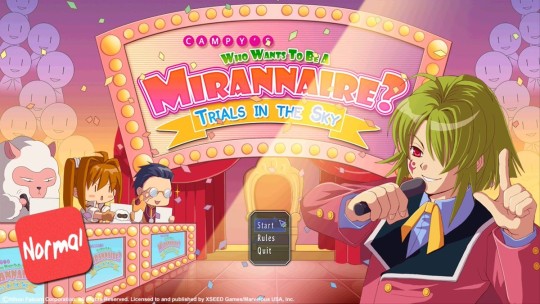
Question: What non-XSEED games do you praise the localization for? - @KlausRealta
Brittany: Final Fantasy XII. I love everything about Final Fantasy XII's writing. I'm also a big fan of the personality in the Ace Attorney localizations. I'm still playing Yakuza 0, but you can feel the passion of the localization team in the writing. There are some projects where you can tell the editing was phoned in, and then there are games where it's obvious it was a labor of love. All of these games have a color I aspire to.
Tom: Probably going to be a popular answer, and not an especially surprising one, but I've got to give props to Lost Odyssey. It's hard to deny the timeless quality and absolutely masterful English writing that went into basically every line of that game's massive script, with the many short stories being of particular note. That game really does represent an inspirational high bar that I think most everyone else in the industry will forever strive to reach in their own works.
For a more unexpected answer, I've also got to give mad props to Sega for their work on Monster World IV. As a Sega Genesis game released digitally in English for the very first time less than a decade ago, I guess I was kind of expecting a fairly basic "throwaway" translation -- but instead, the game boasts a full-on professional grade localization that's easily up to all modern standards, brimming with charm and personality. It's really nice to see a legitimate retro game being given that kind of care and attention in the modern era, and it makes it very easy for me to recommend (as does the fact that the game is actually quite fun, and is sure to be enjoyed by anyone who's played through all the Shantae titles and really wants to try something else along similar lines).
John: I played Okami on PS3 earlier this year (before the remake was announced), and I was awed by how skillfully the team handled text that is chock full of localization challenges like quirky nicknames, references to Japanese fairy tales, and regional dialects. I was especially amused to see a reference to "kibi dango," the dumplings Momotaro uses to bribe his companions in that famous story. We dealt with the same cultural reference with STORY OF SEASONS: Trio of Towns.
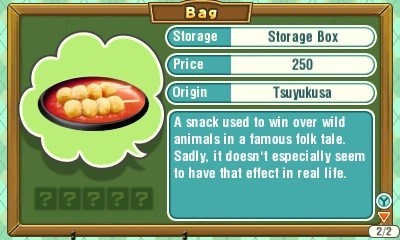
Nick: My go-to response is always Vagrant Story, because it’s the game I credit with getting me really interested in a career in localization. Before that point, I had enjoyed games for their story and characters, but hadn’t realized just how much the specific word choices and tone contributed to a reader’s perception of a story as a whole. The gents behind VS’s localization would go on to be industry luminaries, with Rich Amtower now calling shots in Nintendo’s Treehouse department and Alex Smith being synonymous with the highly regarded prose of Yasumi Matsuno’s games – including the cool and underappreciated Crimson Shroud for 3DS, and Final Fantasy XII, which as anyone who’s played it can tell you is a stellar localization. Having spent a lot of time with FFXII’s “The Zodiac Age” remaster this year, the care and attention to detail put into the localization still blows me away. The unique speech style of the Bhujerbans (with...Sri Lankan inflections, if memory serves correctly) sticks with me, because I knew that I myself would never have been able to pull off something like that so deftly. I guess you could say Vagrant Story started a lineage of games that’s always given me something to aspire to as an editor.
Final Fantasy XIV, which I’ve been playing this year, also has a very good localization, especially considering the reams of text that go into an MMO of its size and scope. Michael-Christopher Koji Fox and his team have done a bang-up job giving life and personality to the land of Eorzea, and I’ve enjoyed seeing how the localization has changed in subtle ways as time has gone on. The initial “A Realm Reborn” localization sort of cranks the “regional flavor” up to 11 with heavy dialects and vernacular, but in subsequent expansions, they kind of eased up on that and have found a good mix between grounded localization and the kind of flourishes that work well in high-fantasy settings.
And, while I haven’t played it in a number of years, I remember Dragon Quest VIII having a really great localization, too, with ol’ Yangus still living large in my memories. Tales of the Abyss was fantastic as well, and both DQVIII and Abyss delivered some really brilliant dub work that showed me how much richer one could make characterization when the writing and the acting really harmonized. I still consider Tales of the Abyss my general favorite game dub to date. The casting is perfect, with not a bad role among them. I also want to give mad props to Ni no Kuni’s Mr. Drippy, just as a perfect storm of great localization decisions. Tidy, mun!
Question: How hard is it to turn in game signs and words to English for Japanese? Is it as simple as going in and editing text? Or as hard as creating a whole new texture for the model? - @KesanovaSSB4
Tom: We refer to this as "graphic text" -- meaning, literally, text contained within graphic images. How it's handled differs from project to project, but the short answer is, yeah, it involves creating a whole new texture for the model. Sometimes, this is handled by the developer: they'll just send us a list of all the graphic text images that exist in-game and what each image says, we'll send that list back to them with translations, and they'll use those translations to create new graphic images on our behalf. For other games, however (particularly PC titles we're more or less spearheading), we'll have to do the graphic edits ourselves. When the original PSDs or what-not exist for the sign images, this is generally pretty easy -- but as you might expect, those aren't always available to us, meaning we'll sometimes have to go to a bit more trouble to get this done.
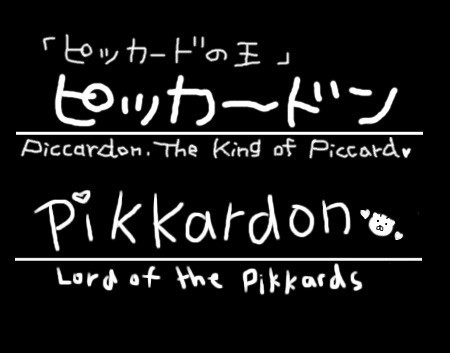
John: The best practice is to review graphic text very early in the localization process because it takes effort to fix and can throw a wrench in schedules if issues are discovered too late. On occasion, it is too difficult to change ubiquitous textures, especially those that might also appear in animation. This was the case with "NewTube" in SENRAN KAGURA Peach Beach Splash, which the localization team wanted to change to "NyuuTube" to make the wordplay clearer to series fans.

Question: With the Steam marketplace becoming increasingly saturated and being seen as a greater risk to publish on in recent times, what does XSEED plan on doing in order to remain prominent and relevant in the PC gaming space? - @myumute
Ken: It is indeed getting harder and harder to stand out as hundreds of new titles are releasing on Steam each month. We are working our way towards simultaneous release across all platforms to help leverage some of the coverage from the console version to get more attention to the PC release, so hopefully that's something we can accomplish soon. For PC-exclusive releases it continues to be a challenge, but at least they have a long tail and even if it's not an immediate success at launch we know it can continue to produce sales for years to come.

Question: What was your favorite film that you saw in 2017, and why? - @Crippeh
John: I'm way behind on movies this year (haven't seen Disaster Artist, Phantom Thread, or Get Out, for example), but recently I've enjoyed both Star Wars and Lady Bird. I expect I'll watch my favorite film from 2017 sometime in 2018.
Ken: Wind River. Mainly because of Jeremy Renner's performance and how many quotable lines he had.
Liz: Get Out for horror mindblowing amazingness, Spider-Man Homecoming for genuinely fun comic book movie, and The Shape of Water for Guillermo del Toro. Guillermo del Toro should always be a category.
That’s it! Stay turned for blog #2 later this week. Here’s a preview of the kinds of questions we’ll be answering:
Question: Have you ever considered selling the music CDs for your licenses stateside? - @LimitTimeGamer Question: If possible, would you please consider researching and localizing classic Korean-made PC xRPGs? - @DragEnRegalia Question: Do you have any interest in pursuing the localization of any of the large, beautiful Chinese RPGs that have been hitting Steam? Or are you focused exclusively on Japanese titles? - @TheDanaAddams Question: What inspired you all to do this kind of work in the first place? Also, what’s the story behind the company name XSEED? How did you all come up with it? - @TBlock_02 Question: What was everyone's favorite game(s) to work on this year? - @ArtistofLegacy Question: What's everyone's favorite song from the Falcom games you've released so far? - @Crippeh
81 notes
·
View notes
Text
Zwei: The Arges Adventure - Localization Blog #2
Tom here again, for more fanboy gushing over Zwei: The Arges Adventure!

I’ve already touched on the game’s amazing script, and I’ll definitely go more into that in my next blog entry (there’s a lot to talk about there, as this is easily the strangest script I’ve ever worked with, on multiple levels!), but I figured I’d take this opportunity now to instead discuss some of the new and updated features that our amazing programmer was able to cram into this release. I’d rank most of these under the “quality-of-life improvements” category, though some are more along the lines of old but notable features from the original 2001 PC version which have been adapted to run more readily on modern systems and integrated more thoroughly into the game proper.
Note that in all cases (except where otherwise noted), the original functionality from the 2001 Japanese release still applies – there are just additional options now as well. Also note that while the additional options described all reference making use of controller buttons, allowances have been made for keyboard shortcuts that fulfill the same functions when applicable, so you keyboard-and-mouse gamers should reap some benefits of Matt’s coding prowess as well.
Anyway, let’s dive right in, shall we?
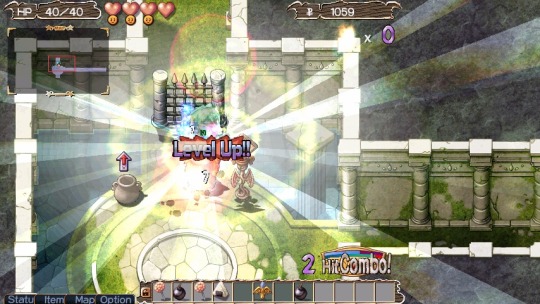
Feature: Quick-using food items in the heat of battle.
How it works in the 2001 Japanese release: In order to use an item, you first have to make sure it’s located on your hotbar (which has 12 available slots). Then, during gameplay, you have to either right-click the item with your mouse, or press the item’s corresponding function key (F1-F12) to use it. If you don’t want to drop your controller to use the mouse or keyboard for this task, no problem: there’s a button you can press that moves control of the game down to the hotbar, at which point you can press left and right to cycle through to the item you want, then press another button to use it. Afterward, you can press another combination of buttons to deselect the hotbar and return to regular gameplay. Time does NOT stop while you do this, however, so good luck surviving the enemy onslaught as you attempt to perform all these tasks!
How it works now: Just press one controller button to instantly use the left-most consumable healing item on your hotbar. After doing so, all other consumable healing items contained therein will shift left as far as they can go, ensuring that the slot you just freed up by using that one item is now located along the right side of the hotbar rather than the left. The reason for this? Well, when you pick up new items, they get sent to your hotbar first, as long as there’s space for them there. And if the blank slot on your hotbar happens to be all the way on the left, then whatever item you just picked up will end up being the first one you use next time you press the item button. But if the blank slot is on the right, whatever item you just picked up will be the LAST one in line for use – meaning, you can customize your own personal “eat list” that determines exactly what items you use on the fly, in exactly what order. Bit of an improvement, wouldn’t you say?

Feature: Switching magic/tools in the heat of battle.
How it works in the 2001 Japanese release: Your hotbar doubles as your equipment slots, so the only way to equip a magic jewel (which determines Pokkle and Pipiro’s attack type) or specialty tool (which allows for various puzzle-solving special abilities) is to add it to your hotbar, then “use” it (via one of the methods listed in my previous feature description), which places the Japanese equivalent of an “Eqp.” symbol over it, signifying that it is now equipped and ready to use. If you “use” that same hotbar slot again, you’ll unequip that item. And if you want to switch to a different magic jewel or tool… well, you either need to open your inventory, drag the new item onto the hotbar in place of the old one, then right-click it to equip it and close your inventory, or – alternately – just keep every equippable magic or tool you think you might be using in the near future on your hotbar (never mind all the food items this is preventing you from prepping!), and press the corresponding function key on your keyboard to equip it whenever the need arises. Siiiimple, right?
How it works now: Whatever your controller’s equivalent of the L1 and R1 buttons happen to be can now be used to cycle through all of your available magic and tools via a single hotbar slot. If you have no such item in your hotbar, but you’ve got one in your inventory, no problem: pressing L1 or R1 will automatically equip whatever you’ve got available into the first available hotbar slot. And from then on, you can just press L1 or R1 to instantly swap it out for whatever the previous or next equippable item in your inventory happens to be. Even unequipping your magic is part of the cycle, for those rare times when you’re attacking enemies who have resistance to all elementals, or when you’re attempting to solve puzzles that call for the use of Pipiro’s base magic.
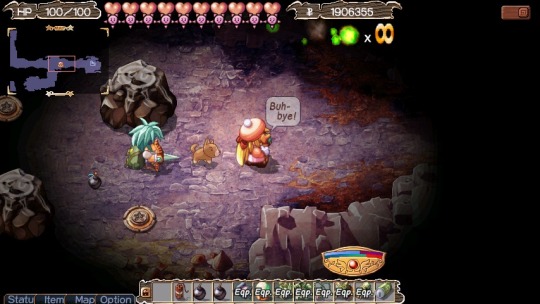
Feature: Dropping bombs or dynamite to blow up enemy artillery or large rocks.
How it works in the 2001 Japanese release: Oh, this one is really fun. Or rather, “fun.” In quotes. See, bombs and dynamite don’t work the same way as any other items. You can’t “use” either of them – attempting to do so will simply do nothing at all. Instead, you have to “discard” them. Using a mouse, this is accomplished via drag-and-drop; assuming there’s a bomb or piece of dynamite on your hotbar, you’ll need to click it and hold the mouse button, then drag it onto the main game screen somewhere and let go to drop it at that spot and set its 3-second fuse. This is made considerably tougher if you’re using a keyboard or controller, since you’ll have to press the button that transfers game control over to the hotbar, scroll over to the bomb or dynamite, press and hold the item-move button, then use the D-pad or arrow keys to move that item onto the main game screen, and finally let go of the button to drop the bomb/dynamite and set its 3-second fuse. But even after that, you’ll need to use the previously mentioned button combo to transfer control back over to your characters before you’re able to move out of the way of the explosion, which… doesn’t always happen in time. And worst of all, if you use any of these methods to attempt to drop a bomb or piece of dynamite, but the location you’re trying to drop it is considered invalid (maybe it’s a little too close to a wall, for example)… well, it’ll just cancel the whole operation and force you to do it all over again. There’s no mincing words here: using bombs and dynamite in the original version of this game suuuuuuuucks…
How it works now: Erm… you press the SELECT button. Basically, if you have at least one bomb or piece of dynamite on your hotbar, pressing the SELECT button will automatically drop it (or drop the left-most bomb or piece of dynamite, if you have multiples on your hotbar) at the closest valid location. That’s literally all there is to it!

Feature: Switching characters on the fly.
How it works in the 2001 Japanese release: There are three options. (1) You can click the character portrait on the bottom-left of the screen. (2) You can press the button to transfer control of the game to your hotbar, then move the cursor over to the portrait on the bottom-left of the screen and “click” it with the item-use button. (3) You can press the Esc key twice, though only if you’re standing still and… really, only if the game feels like honoring those keystrokes (it gets temperamental sometimes). Those are your options.
How it works now: …Yeah, uh, there’s a button for this now. In fact, since Zwei: The Ilvard Insurrection allows for two different control schemes (one button to attack, one button to switch characters; or, one button to switch to Ragna and perform a melee attack, one button to switch to Alwen and perform a magic attack), we decided to mirror that functionality in Zwei: The Arges Adventure with protagonists Pokkle and Pipiro. So whichever option you liked better in the other Zwei game, that option will be available to you here as well!
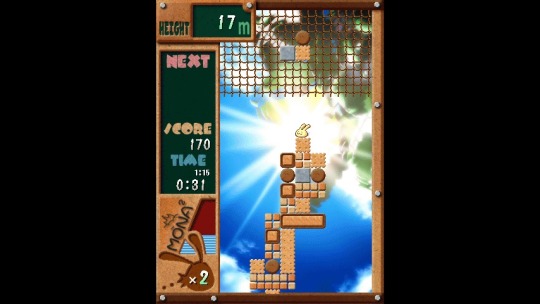
Feature: Playing the “Typing of Ys” and “Mona, Mona” minigames.
How it works in the 2001 Japanese release: These two minigames consist of an Ys-themed typing tutor and a reverse block puzzler (your goal is to avoid making combos at all costs, since you’re trying to build a sturdy block ladder so an infatuated bunny can climb to the top of the level and rendezvous with his true love). They’re pretty awesome. But they’re also a little… unusual in how they’re played. Basically, you have to unlock them in-game through special means, after which point you’re told that “something seems to have happened on the desktop.” Now you can play them whenever you want… from the launcher. You know, the window that pops up when you first boot the game, which allows you to adjust config settings and such? Yeah. You have to exit Zwei in order to play either of these minigames, because they’re only executable from that. They’re part of a small collection of what I’ve come to call “desktop apps,” which also include the likes of a clock, a calendar, and a calculator – all of which are usable ONLY from the launcher.
How it works now: First off, I should note that there is no launcher anymore in our English version of the game. At all. Matt doesn’t believe in launchers, and intends for every configuration option to be accessible and adjustable solely from within the game. So running these minigames from the launcher is simply no longer possible. But that’s okay! It’s kind of beside the point, in fact. The thing you really need to know here is that there’s a third notable minigame as well, called “Zwei Shooting.” It’s a classically styled shoot-em-up (also known as a “shmup,” if you’re rad), and it’s playable (in all Japanese versions of Zwei!! and in Zwei: The Arges Adventure alike) via an arcade cabinet in one specific town. This town has three other arcade cabinets right next to Zwei Shooting’s, but none of them actually have any games attached to them: one just shows you the instructions for Zwei Shooting, and the other two are literally just there for decoration. So we decided, why not assign the “Typing of Ys” and “Mona, Mona” minigames to two of the unused arcade cabinets? And while we were at it, we decided to make them playable right from the start, so as soon as you get to this town, you can play either (or both) of these minigames to your heart’s content! (Which means the conditions for unlocking them in the Japanese version now net you something else entirely, of course…)

Feature: Guiding your pet through dungeons and collecting items via the “Pet Monitor” app.
How it works in the 2001 Japanese release: Once again, this is a “desktop app” that you can run only via the game’s launcher, though this one is available anytime after you’ve acquired a pet in-game. This particular app, however, is largely passive, as your pet meanders through town and into dungeon areas, only occasionally reaching a crossroads or being forced to make some other binary decision (Go left, or go right? Fight the wildcat, or run away? Enter this new dungeon area, or go back home?). When the time comes to make one of these decisions, the pet will turn to face the camera, and you’ll be given the two possible options to select from. Mouse over the one you want (or wait a few seconds and let your pet make up its own mind), and then just keep on watching as the adventure unfolds. Your pet’s exploits can ultimately net it level-ups that will help it be a more effective AI companion during battle in the main game, or perhaps it can net you some extra food items to be used in your own adventures (which are transferred to the storage chest in Pokkle and Pipiro’s house next time you load a save-game).
How it works now: Once again, since there’s no launcher anymore, there’s no more Pet Monitor desktop app. What there is, however (and I’m going somewhere with this, I swear!), is the ability to leave your pet behind at Pokkle and Pipiro’s house as you go off on your journey. This option exists in the original Japanese version too, but there doesn’t seem to be any reason to ever make use of it – there’s never a time when leaving your pet at home would be more beneficial than bringing it with you. But now, it all makes sense! If you leave your pet behind, the Pet Monitor app will automatically appear as part of the HUD when you leave Puck Village, and it will remain on display (with the option to minimize it) the entire time you continue your adventure. So while you’re off fighting monsters and winning back your stolen macguffins, your pet is out somewhere in the same set of dungeons at the same time, finding treasure and fighting wildcats! And any time one of the Pet Monitor’s binary decisions appears on the screen, you may either mouse over the desired option to select it as before, or – if you’re in the heat of battle and can’t put your controller down, for instance – press the L2 or R2 button to select one of the two options without ever having to disrupt your flow. Finally, when you return to Puck Village, the Pet Monitor will automatically minimize as your pet hurries home to pretend like nothing ever happened. It’s the very model of efficiency, and adds a whole new level of meta-gaming to your journey!
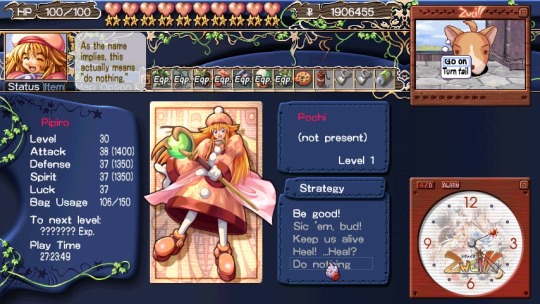
There’s plenty more to discuss, as there have been a bevy of other adjustments made as well (not just mainstays of PC production like widescreen support and achievements, but also simple yet welcome tweaks like the addition of a single button to open the inventory screen, or the streamlining of the game’s formerly rather cumbersome shop functionality). But this blog entry is already quite long, and some of the additions we’ve got on tap are directly tied to the game’s text in some manner… so those are stories best saved for next time around!
Until then, take care, and remember: if you tweeted about this blog entry on behalf of XSEED Games, chances are you Arges.*
…What can I say? When it comes to puns, I’m all about the low-hanging fruit, because it’s just so Ysy. So try not to Mona Mona too loud about it, and just keep on Monitoring this Tumblr for future updates!
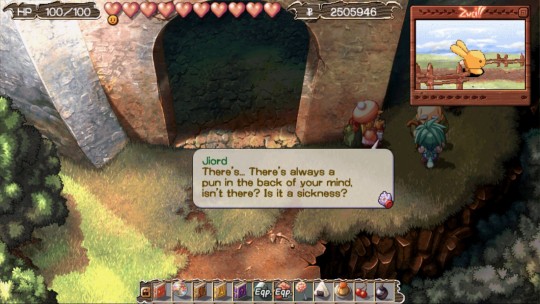
Pipi, cheeri-ro!
*Note: This is actually not the case, as the person who Isges is currently off becoming a Mother 2.0. But the pun was deemed worthy of standing on its own merits, and has thus been left intact for your groaning enjoyment!
36 notes
·
View notes
Text
Zwei: The Arges Adventure - Localization Blog #1
AAAAAAHHHHH IT’S FINALLY HAPPENING.
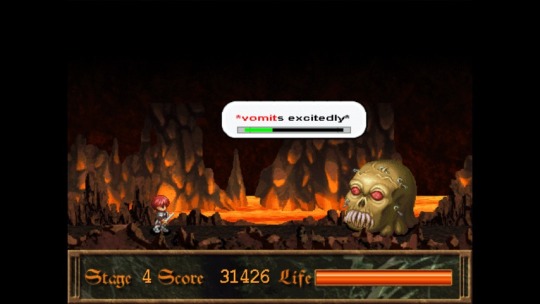
I’ve been working on this game for the better part of a year now, but have been unable to say anything about it for PR reasons – namely, that it wasn’t in a showable state, and we didn’t want to confuse prospective players by having two Zwei games announced but unreleased at the same time. Which is totally reasonable, but AAAAAAAHHHH I’VE BEEN WANTING TO TALK ABOUT THIS GAME SO BADLY YOU HAVE NO IDEA.
…Ahem. First off, I guess I should bring you all up to speed, in case you missed the announcement. Falcom’s 2001 PC classic Zwei!! is coming to the Western world via Steam, GOG, and The Humble Store in early 2018, under the name Zwei: The Arges Adventure. Why the name change? Well, because we already released its 2008 sequel, Zwei: The Ilvard Insurrection (which was originally called Zwei II: Sky-High Great Adventure in Japan).
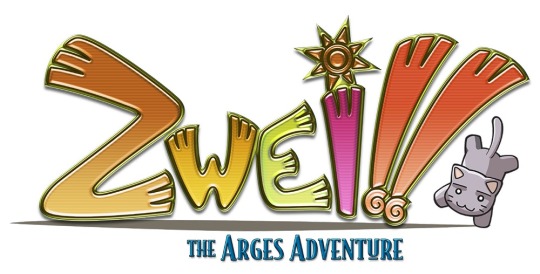
That’s right. Localization work wrapped on the sequel first, and now we’re finishing things up with the original.
What are we thinking?!, you must be asking yourselves. Why would we release the sequel first, then go back and release the original? Why wouldn’t we release the original game first? And since we’ve already released the more modern second entry in the series from seven years later, can this earlier effort really hold its own by comparison?

Well, that’s why I’m so excited. Because Zwei: The Arges Adventure is good. REALLY good. In fact, I dare say it’s my favorite translation I’ve ever worked on to date – yes, even topping Return to PopoloCrois and Corpse Party. And if you’re at all familiar with me (this is Tom, BTW), that statement alone should tell you that Zwei: AA is something special, since PopoloCrois and Corpse Party are… shall we say, perennial favorites of mine. To put it very lightly.
So, yeah. Let’s address those hypothetical questions, shall we?

Why would we release the sequel before the original? Well, two reasons. One, because we can – these games each tell standalone stories, set on different floating continents with different casts of characters. Zwei: AA’s two protagonists, Pipiro and Pokkle, do make a few cameo appearances in Zwei: II, but this is done almost purely for the sake of fanservice (the literal kind, not the naughty kind). When all is said and done, these two games are completely standalone, taking place in the same world but telling very different stories with very different characters and a very different feel. Think of it kind of like the Ys series, but even more episodic (since, Ys Origin aside, Ys has the Adol-as-protagonist connection from one game to the next, whereas Zwei doesn’t even have that!).
The other reason is because of the nature of Zwei: AA’s code. The Japanese version of this game utilized DirectX 5, was formatted strictly for 4:3 resolution with no widescreen options whatsoever, offered a lovely FPS selection of 30 or 15 (seriously!), counted on players to play it with mouse and keyboard over gamepad (it supported gamepads, but… barely), and contained no fewer than six unlockable Windows desktop apps that were loosely tied to yet completely separate from the main game.
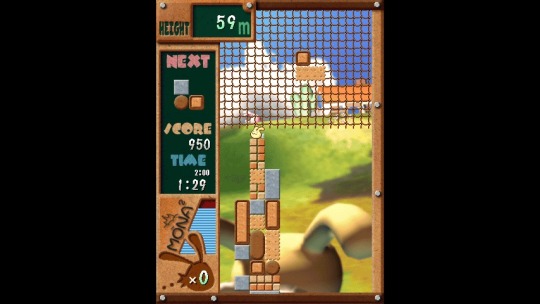
This is one of them. And that first screenshot at the beginning of this blog entry is another.
In other words… this is the kind of adaptive coding project that’s been known to give lesser programmers heart attacks. Getting a game like this to even run on a modern Windows machine at all – much less run WELL – was decidedly not a task for the meek. In fact, it’s because of the way this game is coded that we ultimately decided to translate the game in-house rather than working with any fan-translators as we did for Zwei: II, as no two programmers would handle this text the same way – and trying to convert a fan-translated script to a format that would work for us would’ve taken almost as long as translating the game from scratch.
So, yeah. Getting Zwei: II out first was pretty much just done because… erm… it was ready first. And it was always GOING to be ready first. Even with a lengthy QA process and a couple minor delays, it still inevitably got finished long before its predecessor was ready to make its debut.
Fortunately, we hired a veteran programmer to work with us on Zwei: AA… but you’ll never guess who! It wasn’t Sara, since she was busy getting Zwei: II ready at the time (and a fine job she did of it, with one of our smoothest PC launches ever!). But this wasn’t our first time working with the guy we worked with on this project, either. It was, however, our first time working with him to modernize someone else’s game – and he really did perform some miracles for us (and put up with my many, many demands for quality-of-life improvements and feature additions, to boot!).
The man in question? Matt Fielding, of Magnetic Realms. A.k.a. the guy who brought you the game Exile’s End.
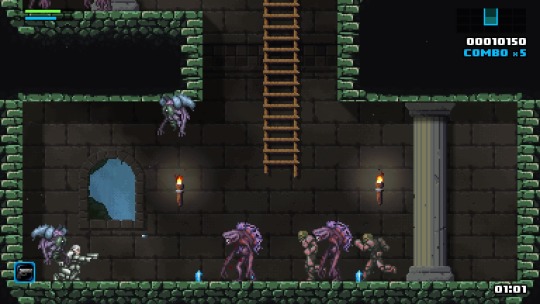
Pictured: Exile’s End. Which is also an awesome game you should play!
And thanks to his technical wizardry, you guys are going to have an astoundingly up-to-date version of Zwei!! on your hands at launch. We’re talking more than just widescreen support here – there’s full in-game integration of the Pet Monitor and other desktop apps, new control functionality for more natural gamepad support across the board, inclusion of the arranged soundtrack from the Japan-only PSP version of the game, additional art and text content not present in any previous version of the game, and much, much more (to be detailed in future blog entries!).
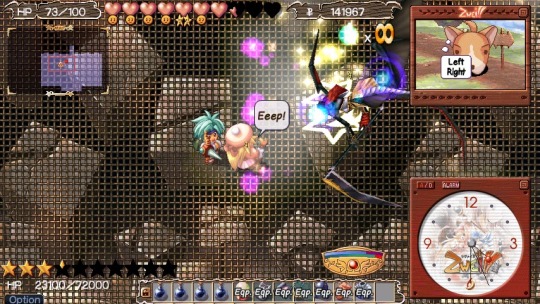
Moving on to the second question I asked, with Zwei: II already out, can Zwei: AA hold its own by comparison?
I think you know what my answer’s going to be, on that one. Zwei: The Arges Adventure is a freaking awesome game with a lot to offer, and differs from its own successor in enough key areas that it can very easily hold its own any day of the week. Hell, you might even like it better than Zwei: II – it’s certainly a very close call for me, but I’d say Zwei: AA gets the slight edge!
Sure, they’re both dungeon-crawling action RPGs at their core, and they both use food to level-up, even sharing the same food exchange system to discourage grinding. And the two-character party (plus one pet), with one character taking the role of physical attacker while the other slings spells, takes center stage in both titles as well. Plus, both games are set on floating continents in the same world.
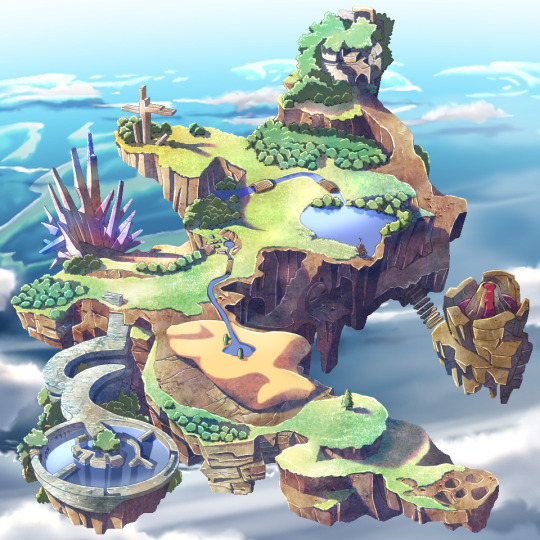
That’s a lot of similarities, but they’re all relatively superficial. You could say Zwei: AA is like the 2D answer to Zwei: II’s 3D world, but that would be discounting its snarkier and more tongue-in-cheek storyline (yes, even more than Zwei: II’s!), or the gorgeous and ludicrously colorful hand-drawn backgrounds, or the two games’ very different approaches to pets (you only get one pet in Zwei: AA as opposed to the veritable army of pets featured in Zwei: II, but that one dog or cat [or other?] has significantly more personality and gameplay involvement than its many Zwei: II counterparts), or the huge variety of minigames on offer (all of which have been adapted to play from within the game itself, despite formerly existing only as desktop apps)… and that’s just scratching the surface. In short, although the two games use the same basic template, they represent two very different approaches to game design within the confines of that template.
For me as Zwei: AA’s translator, though, I can’t help but laser-focus right on the game’s dialogue. Protagonist duo Pipiro and Pokkle are without a doubt the best pair to write that somebody like me could ever ask for. Pokkle constantly cracks bad puns (and I do mean constantly!), wears a tail for funsies, and is always hitting on women twice his age.
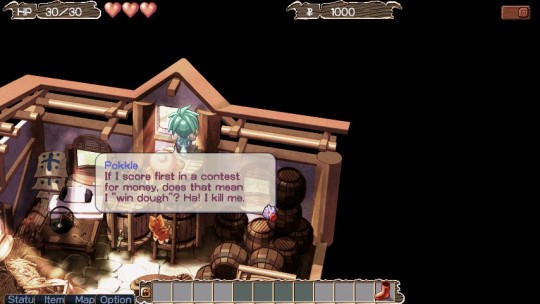
And Pipiro just has absolutely no filter whatsoever, and is full of so much snark that she’s fit to burst.
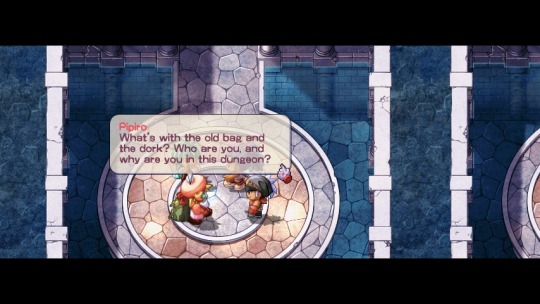
Practically every line out of these two is an absolute gem – and that’s to say nothing of the many quirky NPCs surrounding them over the course of their rather lengthy quest (such as the endlessly self-delusional “libertine fatass” that’s funding your adventure, and his extremely no-nonsense maid who gave him that nickname).

I… really can’t stress enough how much fun it was to write for these characters, and how inspired I was to come up with the perfect phrasing for every line. I’m extremely appreciative that we chose to translate the game in-house, as it gave me an opportunity to work much more deeply with this script than I ever could’ve if we’d only been tasked with editing it. As time went on, I found myself revising my work on a daily basis, making small tweaks here and there as new bits of wordplay or better puns popped into my head (much to Matt’s chagrin, I’m sure!). The end result is something that I can stand behind as a faithful interpretation of the game’s mood and intent – an attempt to convey the same degree of lighthearted fun and irreverence present in every line of the Japanese script, but formatted to sound more natural in English, accounting for context, tone, atmosphere, and individual character quirks rather than just hammering out a word-for-word translation.
I’ve never laughed so hard while playing a JRPG before, and I truly hope that when you guys play this one in English, you’ll find its English interpretation just as hilarious as I found its original Japanese to be. That would mean I succeeded at what I set out to do, and would bring me great joy and pride as a localizer!

And please do keep an eye on this Tumblr, as I fully intend to give lots more info about Zwei: The Arges Adventure (and more screenshots showing off lines I’m particularly proud of) in the weeks to come!
Until then, I hope you’re all continuing to enjoy Zwei: The Ilvard Insurrection, and… well, I’mma go back to testin’ Zwei: The Arges Adventure now, ‘cause I want this game to be downright perfect when it’s released! And with translation and editing 100% complete, and coding probably somewhere in the 70-80% done range, that release date will be here before you know it…
73 notes
·
View notes
Text
Story of Seasons: Trio of Towns DLC Localization Blog #2
Howdy, everybody!
Welcome to what I think will be the final localization blog for STORY OF SEASONS: Trio of Towns. As you might have seen, we announced a release date (Nov. 9) and price ($7.99) for the Trio of Towns DLC. We are also, at long last, able to release the Trio of Towns 3DS theme on the North American eShop for $1.99. I apologize for the drought of information between our last blog post and now. Production proved to be challenging in unforeseen ways, and we didn’t want to give out new info before we were certain the content was ready to be released.

A scene from one of the DLC events.
I’d like to use this blog to lay out all the content that will be released next Thursday.
Patch
The Version 1.1 patch will either be automatically downloaded to your 3DS system, or you can find it on the eShop and download it from there.
In addition to the bug fixes and text corrections mentioned in our previous blog, this patch will add four outfits. These include Lest and Frey’s outfits from our 2013 release Rune Factory 4. We wanted to distribute these outfits to all players as thanks for their support of Trio of Towns, and their patience during the development of the game’s extra content. Once the update is installed, the new clothing items will be available for purchase at Ludus’ shop (the Rune Factory 4 outfits) and the wholesale store in Tsuyukusa (the Perfect Dress and Poodle outfits).
I’m including screenshots of the ingredients needed to make each, so those of you who want to cosplay Lest/Frey (or voice actress Ayana Taketatsu, who inspired the Perfect outfits) can start getting the materials together.

Princess’ Attire

Prince’s Attire

Perfect Top Hat

Perfect Dress

Poodle Hat

Poodle Costume
DLC
Once you’ve downloaded the 1.1 patch, the DLC, called the “New Neighbors Pack,” will be purchasable from a newly added “Downloadable Content” menu on the title screen.

Follow us for more thrilling screenshots of menus!
We decided to roll all of the content into one DLC package, which allowed us to reduce its cost from our original estimate to $7.99. This “New Neighbors Pack” is the only DLC for the game, and will contain almost* everything from the four post-launch Japanese patches:
Marriage candidates Woofio and Stephanie
The ability to have a child with Inari
Events such as cultural exchanges among the three towns and a visit from your father
Events immediately following the New Year’s Festival and Starlight Gala
About 50 new lines of dialogue per marriage candidate, including clothing/pet reactions
5 special winter outfits
A performer story
We’ve posted lots of screenshots from this content on the STORY OF SEASONS Facebook page over the past few months. For more information on Woofio and Stephanie, be sure to check back there next week.
If you were wondering, players with the retail game, the patch, and the DLC can all play online with one another without issue. The new outfits will just show up as the default outfit if you are playing on a version without the added data.
*As with Hamtaro, we were unable to secure the rights to use Chebrashka, so this little Russian character is missing from our release.
Theme
This theme features the bachelors and bachelorettes (sadly, it is missing Woofio and Stephanie), and plays one of the romance event songs. You can purchase it (and the STORY OF SEASONS and Rune Factory 4) themes from the Theme Shop on your Nintendo 3DS.

It has been a long road to releasing this extra content, from our first blog post asking for feedback to release about 9 months later. The process of translating and editing was smooth, but we hit several roadblocks during production. Still, I think that Trio of Towns is a really special entry in this long-running series (though I’m obviously a little biased), and so even though we’ve made you wait, I hope that you will enjoy this opportunity to interact with Westown, Tsuyukusa, and Lulukoko in new ways.
#XSEED#XSEED Games#Marvelous#Story of Seasons#Trio of Towns#Woofio#Stephanie#DLC#Post: John#Bokujo#Localization
414 notes
·
View notes
Text
Zwei: The Ilvard Insurrection - Localization Blog #4
Can you hear it? A voice, booming and boisterous, blowing in upon the cool winds of autumn. A voice that beckons you to come sit a spell and play a good ol’ videogame. “They don’t make ‘em like this no more,” it says. “Well...most don’t. That’s why we need to sell a bunch’a copies, so they’ll get right to making Zwei 3! Yes siree, with Falcom’s storied lineage of action RPGs, it’d be a slam dunk! Ghahahaha!” That voice...is my voice, broad as the sea and hearty as a meal that consists solely of potatoes and slabs of meat.
That’s right, true believers, it’s Nick, here once again to share with you the myriad fascinations of working in videogame localization. If you’ve been keeping up, this is the fourth blog I’ve written about the upcoming release of Zwei: The Ilvard Insurrection. The first entry gave a basic rundown of what the game is like and what you can expect from it, while the second entry went into more depth about the localization work and the nuances of character writing. The third entry was a progress report, detailing where we were in the QA cycle and why we’d be missing our summer release date.
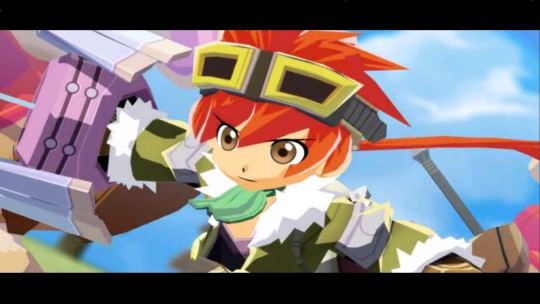
Today, I’d like to tell you a story: the tale of how Zwei: II ended up with the expanded English voice acting it now boasts. Although this news has been known ever since we officially announced the game, I haven’t seen much discussion surrounding it, but the process of how “let’s add voice acting” went from pie-in-the-sky thought to reality is one I think you’ll find fascinating.
See, the interesting thing isn’t that we added English dubbing to Zwei: II. We weren’t able to secure the rights for the original Japanese voices, so it was pretty much a given we were going to do a dub. No, the most interesting part is that the dub adds a LOT more voicework than was present in the original. Why did we do that? How did we decide what to dub? And how much more is there, exactly? This and more I shall unfold for you, dear reader!
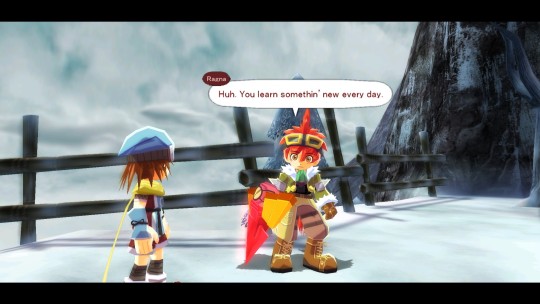
Zwei: II was designed without voice acting in its story scenes, and it holds up perfectly well that way, as classic RPGs do. But, that said, Zwei’s story is very driven by its outsized personalities. The characters really sell the scenes, and while I wrote for each of the characters in such a way as to accomplish that without the need for voice acting, their sometimes-cartoonish gusto and theatricality seemed like they’d be even more colorful when brought to life by VAs. I talked with the big boss, Ken, about the prospect, and he told me to put together a script so we could have the studio price out how much it would cost us.
To be honest, I’m still kind of surprised Ken was open to it. After all, Zwei: II isn’t a console release of a modern title – it’s a PC release of an older title. Maybe that goes to show how well-received Japanese games have been on PC in the last several years. Personally, I think a well-received game like Cold Steel leading the charge as far as “adding additional voice acting to a PC port” did a lot to open the door for a more modest title like Zwei to get a significant bump in voice acting. But success here provided my first challenge: putting together a script.
Now that adding more voice acting was on the table, the question then became, “Okay, so what do we actually voice?” All the battle stuff was covered at a bare minimum due to the fact that it was in the Japanese voice script, so the natural answer was, “Let’s just voice all the main story.” That’s a reasonable target, and not exceedingly difficult to pull from the full game script, since many of the main story scenes are positioned just before and after the game’s major boss battles. I began to assemble a “story scenes” voice script with all the scenes I thought most essential to conveying the game’s narrative, breaking it down scene by scene. After handing off a first draft to the studio and getting their estimate, I was given the green light, since it had apparently come in under what we were expecting.
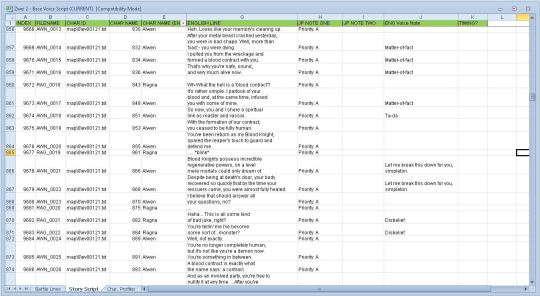
But of course, ever being one to press my luck, I said, “Wellllll...actually there are a couple more scenes I COULD include!” And with a resigned sigh from Ken, I went back in and added a few scenes I had opted to leave on the cutting room floor during my first draft. As things stand, the new voice script’s coverage of story events isn’t perfect – there’s still one boss battle that has its before/after scenes unvoiced (I chose that one to drop because I felt that what was expressed there is also expressed in other voiced scenes well enough), but such are the choices one has to make at the crossroads of idealism and budgetary limitations.
The whole “voicing scenes before and after boss battles” approach worked well because it set up a good amount of consistency as to when players could expect to hear something voiced. It also, by the very nature of the scenes chosen, is really good at building the personalities of the game’s antagonists – which is helpful since they do a lot to spur Ragna and Alwen’s growth.
The unfortunate downside to my scene-selecting methodology is that I didn’t get to include many scenes outside of those. There are only two voiced scenes that aren’t tied to before/after boss encounters – one in which Ragna talks about his past (which I thought gave good insight into his character), and a key one at the very start of the game in which Ragna discovers that Alwen is, in fact, a vampire, and they have their first long discussion about their blood contract and how Ragna wants to be equal partners. That’s such a defining scene that sets up both protagonists perfectly for everything that is to come that there was never any doubt in my mind that I wanted that one voiced.
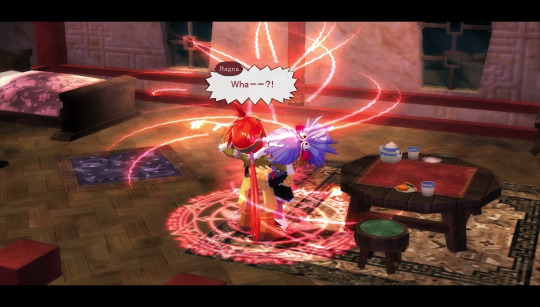
At this point, let’s stop for a moment and examine the script. The original Japanese script was 808 lines. The number of lines in the new voice script, however, clocked in at 2807. That’s basically 2000 newly voiced lines, all story. And while it may not seem gigantic in light of a game like Trails of Cold Steel, you’ll certainly be able to feel the presence of the voice acting as you play through the game. Ragna and Alwen in particular saw massive increases: from 88 and 89 to 724 and 548, respectively. We even picked up an entirely new character who had no lines in the original Japanese voice script but did factor into several of the story scenes I had selected!
When casting, I conferred with both Tom and Kris to get their general impressions, and to solicit suggestions in cases where I didn’t have any particular VA in mind. Zwei: II is a game that wears its heart on its sleeve, so I was casting with an ear toward a “Saturday Morning Cartoon” feel – expressive voices that have a touch of exaggeration in them. It was a different feel than we’d chased when casting for Trails of Cold Steel, but it got us the sound we were looking for.
Recording took six days, with a stream of VAs coming in to lend us their talent. John accompanied me for the first couple days, while Tom helped in the latter half, both lending some much-welcomed aid by helping me keep track of any changes we made to lines during recording while I was focusing on the line deliveries. To level with you a bit here, I’ve never been the most organized person, so the voice recording process, with its focus on having everything triple-checked and accounted for, has always felt pretty daunting to me. After all, there’s always that cold dread that you’ll have an actor in the booth and suddenly, some problem with the script files will pop up, costing you precious time when every minute has value. Thankfully, there were no complications with Zwei’s recording – it was actually a pretty smooth, pleasant time (though very busy). Some of our VAs I had worked with before, so seeing them again and trying them in different-sounding roles was fun. Other VAs I was meeting for the first time, and I enjoyed getting to see them at work, as well as seeing what kind of vocal ranges they could pull off (always helpful when we’re brainstorming voice casts for future projects).
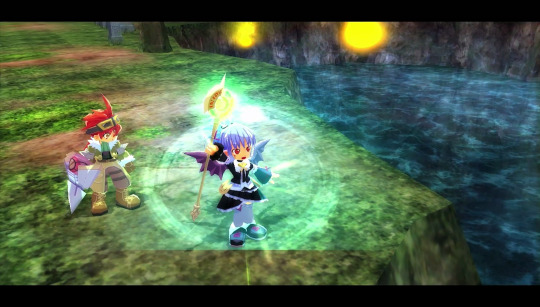
Our voice director was someone I’d met before, and in fact someone I requested by name after discerning how deep his knowledge ran concerning things of the nerdy persuasion. For Zwei, I didn’t want to take a chance on a director that only had a surface-level understanding of anime – I wanted to be able to throw out oddly specific requests like “Play it more like X from the series Y!” and have them understand the voicing intent behind that and translate it into instructions the VAs could make sense of.
Talking with him over the course of the project was a mile-a-minute ride, but among all the really nerdy stuff we talked about, one common thread that really stuck with me is his identification of Zwei as a “pulp story.” Before then, I’d approached Zwei in my mind from that anime-centric perspective it so clearly embodies, but our conversations got me wondering how, as a fan of pulp-style stuff, I’d never consciously made that connection before. In another universe where Zwei wasn’t a Japanese videogame, it feels like it’d be a natural fit as a weekly radio serial. The character influences I mentioned in my second blog post all led to “pulp” too, when I followed the strings back.
Back at work, I reviewed all the voice files and marked the ones that needed filters applied, as you do when, for instance, someone is talking to a character telepathically or is possessed by a demon (y’know, your general RPG happenings), and we got them into the game. There’s something of a sense of trepidation that comes when you finally drop all those voices into the game proper. You hold your breath, thinking, “That was so much work... I reeeeeeally hope this sounds good!” Fortunately, our VAs didn’t disappoint, and hearing some of my favorite scenes brought to life through performance really helped sell the emotion of the scenes, just as I’d hoped at the outset.
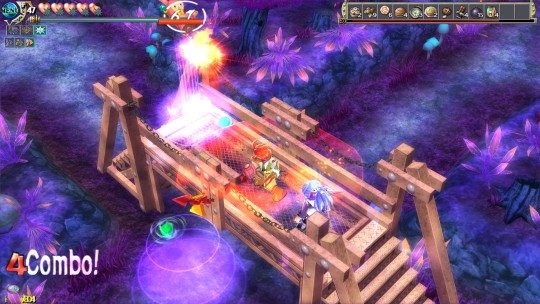
Now, maybe you’re not fond of dubs. Or maybe you’re a purist, wanting to experience the game without the addition of a bunch of voice acting that wasn’t in the original. Believe me, I totally understand you. Thankfully, the voice volume is on a separate slider, so you can crank it down and read through at your own pace, with the voices you imagine the characters to have. That kind of experience is fun too, I think, and I’m interested in what those of you who play it both ways think about the ways in which the dub shapes how one perceives the story and characters.
Of course, for you fans of RPG dubs, I’m also interested to discover which characters will become fan-favorites and which lines will be the most entertaining and memorable. Our programmer, Sara, has even gone above and beyond with filled-out lip flap for the dubbed scenes! In the original game, there’s a brief lip-flap that’s tied to the scroll-out speed of text in a character’s text box. What that means in practice is that their mouths move for about a second while the text is displaying, then once it’s all there on screen, their mouth doesn’t move anymore. It’s a perfectly sensible setup for a game without voiced story lines, but in the cases where lines were voiced, I wanted the lip flap to continue as long as the voiced line was still playing. From the sound of it, it took some real doing, but the lip flap does indeed now track to the length of the voice clip in cases where story lines are voiced. It might seem to be a minor detail, but I think it’s details like this that help make the experience feel well integrated and authentic.
In any case, you won’t have to wonder too much longer what the game sounds like, because it’s finally out in less than a week, with a Trueblood vampire-approved release date of October 31st. I hope you’ll enjoy playing it as much as I enjoyed working on it. After all...everyone could use a little more PASSION in their souls!
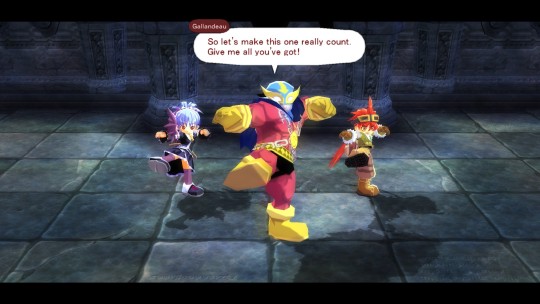
38 notes
·
View notes
Text
Zwei: The Ilvard Insurrection Micro-bloggery Round-up

A very Zwei Q&A with editor Nick!
1) I've got a huge backlog of games. Why should I bump Zwei to the front of the queue?
It's been a great year in videogames - perhaps TOO great, if my own backlog stack is any indication, and I have no doubt that many (most?) of you are in the same boat. But every now and then, we'll get our hands on a game and it sort of effortlessly floats to the front of the queue, like it bought an expensive theme park pass. I'm under no illusion that Zwei will be "that game" for everyone, but for some of you, it might be! Let's look at a couple reasons why Zwei: The Ilvard Insurrection might be just the game you've been looking for (but didn't realize it)!
First, it's got a great "medium" length. You won't be rolling the credits in 10 hours, but it's also not an 80+ hour bear where you just look at it and sigh and think, "I know I'll love this, but...when will I find the time to play it?" With Zwei: II's 30-ish hour average playtime, it offers a fulfilling action RPG experience you can sink your teeth into, but you won't need to cancel all your plans for the next month to make time for it.
Second, Zwei represents a heretofore-unknown prong of Falcom's action RPG legacy. Falcom is famous for Ys, an action RPG series that has spanned decades at this point, and other titles in a roughly similar vein, like Brandish and Xanadu - in fact, it's been joked that Falcom's "XYZ" is Xanadu, Ys, and Zwei. But unlike many of their other offerings, nothing from the Zwei series has ever been officially available outside Japan...until now. As Falcom's last/most recent PC-exclusive title (made in 2008), it straddles a fun line between old-school charm and modern conveniences and storytelling. It's the Falcom quality you know, but in a world distinctly different from their other games.
Third, Zwei is made to be easy to pick up and spend some time with without having to invest a ton of time in a sitting. Dungeons are generally broken up into discrete "branches," each of which can be undertaken on its own, with save points in between and the ability to fast-travel between any save point you've been to at least once. If you've got 30 minutes, you can get something done in Zwei. If you've got an hour, you can do even more! The game reflects modern sensibilities regarding variances in player engagement and time commitment, and that makes it really easy to pick up whenever you feel like playing.
If any of that piques your interest, I'd invite you to consider bumping Zwei to the front of your gaming queue.

2) I love Falcom stuff like Ys and Trails, but this one seems...a little bit different. How does it compare? Will I like it?
As a Falcom action RPG, Zwei: The Ilvard Insurrection fits into a long legacy of storied games, and ultimately, as fans, we can't help but draw comparisons. But I think overall, these are helpful comparisons to make, because in doing so, you can see where a game like Zwei 2 fits into Falcom's growth as a developer over time.
The original Zwei was released in 2001. It's more of a straight dungeon-crawler than its sequel, The Ilvard Insurrection, is, but it featured the mechanic that would go on to be the series' calling card: two main characters, one specializing in melee attacks and one specializing in magic, who could be swapped between at any time with the tap of a button. However, Japanese fans would have to wait until 2008 to play the second game in the series.
Tom, our resident Falcom historian, slots the Zwei series into a gameplay lineage that also includes Gurumin (made in between the first and second Zwei games) and Nayuta no Kiseki (made after the second Zwei game). That separates it from the gameplay stylings of series like Ys or Xanadu, while still feeling pretty easy to get into for anyone who's played those games before. Visually, Gurumin probably has the most "Zwei DNA" of any of Falcom's other titles, as it features gameplay and even visuals that feel like they could easily have been part of a Zwei game.
The combat in Zwei is not as technical as in the Ys games - it takes more of a "big picture" approach, in the sense that often, your biggest advantages can be gained not in one's mastery of controls or precise techniques, but in when you choose to swap between characters to chain their actions, and how you position yourself within spaces and relative to the enemies. Personally, I feel like this lends a bit more of an "arcade beat-em-up" feel to Zwei's action RPG combat, so if that sounds like your kind of thing, well, get ready to grab your spoon and dig in.
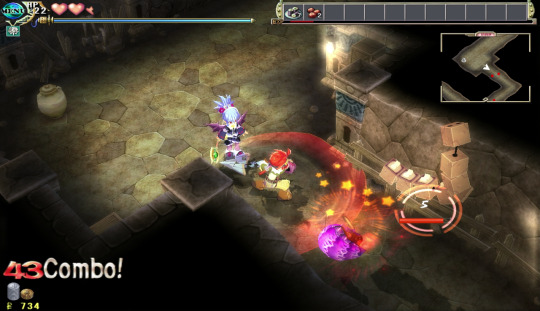
3) I've heard Zwei: The Ilvard Insurrection has an unusual leveling system. What can you tell me about macaroni gratin and the power it bestows?
Well, macaroni gratin is delicious, and anyone who says otherwise is a just lookin' to foment some dissent at the lunch tables. BRING IT.
...Er, what I mean to say is, the Zwei series' leveling system is one of its most unique aspects. Instead of getting EXP from killing monsters, you gain EXP from eating food. This same food serves double duty as the main consumable items you use to heal yourself when you take damage, and you'll get plenty of it as you go through the game. It might sound weird, but it works surprisingly well, and sets up some interesting scenarios. If you want to strongarm your way through dungeons, you can be more proactive about eating food to gain EXP and keep on par with or a little above each dungeon's recommended level (as displayed by a metal plate on the floor before every dungeon branch). If you want to give yourself more of a challenge, you can use food only when you need to heal, and treat the EXP you gain as a residual bonus.
You can even just decide to enforce minimal food-usage (or not at all) and see how low of a level you can go through the game with, if you want to give yourself a real challenge. The game doesn't have standard difficulty levels, but the way in which you use food sort of lets you scale the game's difficulty as you see fit.
In addition, the game's foods fit into four different "tiers," and you can trade in ten of any one type of food for one of the "evolution" of that food in the next tier, with the higher-tier food giving 150% more EXP than 10 of the food that came before. It might sound confusing, but it's really not. Here's a quick example. I've got ten plates of Pasta Carbonara. Each one heals 28 HP and gives 2250 EXP when consumed. But, if I take those ten plates of Pasta Carbonara and trade 'em in at the restaurant counter, I'll get one plate of delicious Macaroni Gratin, which heals 38 HP (not a huge upgrade there), but gives a whopping 33,750 EXP when consumed. As you go further in the game, upgrading is more about maximizing your EXP gain versus raw healing amounts. If more raw healing is what you want, though, it may be worth NOT trading food up, because those ten plates of Pasta Carbonara can heal 280 HP - somewhere between two and three full life bars of health at high levels!

4) Got any advice for players? Must see or do stuff?
My best advice for players is to really think about the different types of magic Alwen has and what they're good for. Some magic, like fire, is all about just blasting enemies and puttin' the hurt on them. Other types of magic are, on their face, a bit weaker: ice launches only single shots that have a more limited range, wind whips up a small tornado that sweeps forward - but when you think about all the tools at your disposal, and especially how you can position or lock down enemies (known colloquially as "crowd control"), options that aren't just MAXIMUM DAMAGE BAM RIGHT IN THE BACK OF THE HEAD WITH A FOLDING CHAIR really shine. In fact, if you decide to spelunk through the optional dungeon, you'll need these strategies, because brute forcing your way will only take you so far.
Another piece of advice is to take the time to actually talk to NPCs. I admit, it's a common thing to hear from a localization editor ("Please read this dialogue that I edited!"), but Zwei is a game with a very clear through-line, and if you want to, you can stay on that track, never really go places when it's not necessary to, and finish the game with little trouble. But to do so would be denying yourself the chance to learn more about the amusing people who populate the game's world. Taking a page from the Trails series, Zwei has NPCs who often change up what they say after both major and minor game events, and the NPCs have their own individual stories that develop as the game goes on. It's worth your while to poke around and visit people, because there are many unique conversation snippets in the game that only play when you talk to someone at a particular phase of the game, and often there will even be differences in the dialogue depending on whether Ragna or Alwen is active as your lead character.

5) Since you’re known for your puns, give us your best shot. Which ones are you most proud of?
Surprisingly, Zwei: The Ilvard Insurrection isn't particularly full of puns! Zwei: II's style of humor leans much more toward pithy commentary and snarky asides, often made from one partner to the other in the middle of a conversation, or just "thought aloud." Cheekiness seems to be a popular personality trait in the land of Ilvard, as the townsfolk and even the animals (...if you can talk with the animals) get in on the action. Pokkle, one half of the first Zwei game's protagonist duo, is an inveterate punster, and while he does appear in this game in a cameo role, he's not firing off puns left and right here. However...you can choose him as an opponent in the game's battle arena, and if you select Ragna to fight him and win, upon being beaten, Pokkle will moan, "I just got Ragna-rocked!" It's voiced, too, so enjoy that!
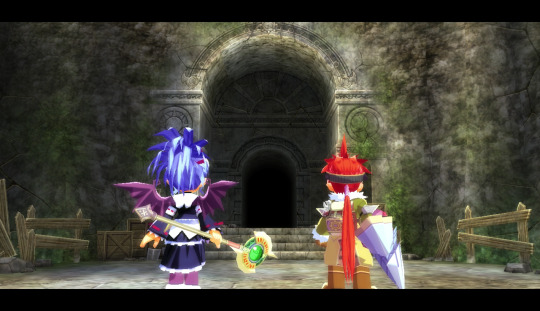
Service Penguin says thanks for reading, and be sure to check out the official Zwei: The Ilvard Insurrection site at: http://visitilvard.com/!
Zwei on STEAM!
Zwei on GOG!
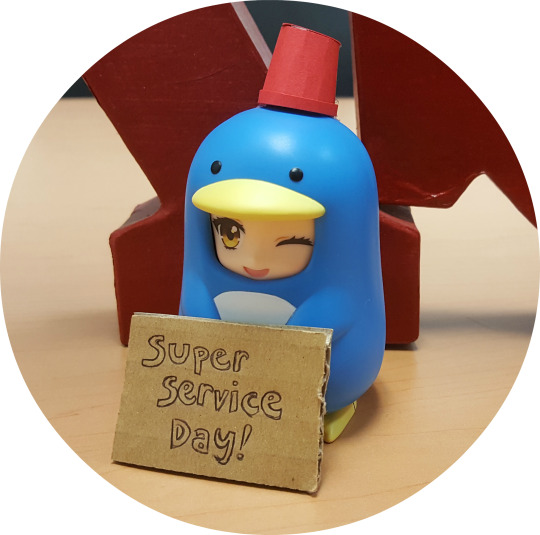
57 notes
·
View notes